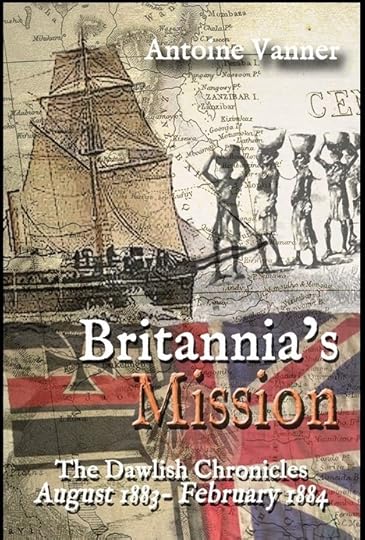Antoine Vanner's Blog, page 9
September 16, 2022
Hell and High Water: HMS Nautilus, Part 1
 Hell and High Water: HMS Nautilus, 1807Part 1
Hell and High Water: HMS Nautilus, 1807Part 1In November 1806 a Royal Navy squadron commanded by Admiral Sir John Duckworth (1748 – 1817) was sent to reconnoitre the Dardanelles as a preliminary for a move against Constantinople (now Istanbul) in what would be the Anglo-Turkish War of 1807-1809. Attached to the force was an 18-gun sloop, HMS Nautilus, launched in 1804 and captained by a twenty-six year old officer named Palmer (Does anybody know more about him?)

Though this painting by Antoine Roux (1765-1835) is of a French brig, HMS Nautilus would have looked generally similar
On January 3rd 1807 HMS Nautilus was sent to Britain with despatches. Driven by a strong north-easterly and guided by a Greek pilot, she safely navigated through the cluster of Aegean Islands between Greece and Anatolia. When the pilot stated however that the had now passed his point of knowledge of the area, Palmer himself now took charge. By this stage he seemed to have been exhausted, having hardly slept for three nights, and, after setting a course on the chart for his coxswain, George Smith, to follow, went to bed. The wind was beginning to strengthen but, though the night was very dark, Palmer had been satisfied that constant lightning on the horizon provided sufficient illumination to identify any land ahead.

HMS Zebra – a typical Royal Navy brig of war, by Giovanni Schranz (1794-1882)
Under light sail, and with a following sea, HMS Nautilus was estimated to be making over nine knots. Around two-thirty in the morning, high land was detected ahead, and believed to be the island of Antikythera, between Crete and Peloponnese. HMS Nautilus’s course was altered to pass and she drove on for two hours until a look-out warned of breakers ahead. It was too late – the ship struck violently. Those below hurried on deck – water was already surging into the aftermost past of the hull.
Captain Palmer appeared, ensured calm, and went with his second lieutenant to inspect the damage. He saw that the situation was hopeless and he returned to his cabin to burn his papers and private signals. The sea was now lifting the hull and smashing it down again repeatedly on the rocks so that the decks became untenable and the crew – HMS Nautilus carried a total of 122 officers and men – were forced up the rigging to survive.
The lightning had ceased by now and the darkness was almost total. It was only a matter of time before the ship would break up completely. All boats were smashed but a whaler (whale-boat in American parlance) hanging over the quarter survived. In this an officer, George Smith the coxswain, and nine men, got away. For those left on board HMS Nautilus the only hope of survival lay in getting to the exposed rocks. Just before daybreak the mainmast fell over, falling towards the rocks, and this provided a bridge across which to scramble. By this stage several men had been drowned, and others were injured, but Palmer refused to cross until the last man had left. He was injured in the attempt and was dragged over by several seamen who came to his rescue.
The rock on which they found themselves was likely to be overwhelmed by the waves and safety now lay in wading to a larger rock. The first lieutenant managed to get across the intervening channel and encouraged the remainder to follow, the passage being made all the more dangerous by wreckage from the ship being carried through the channel by the waves. Many were injured while crossing and those not wearing shoes – this was an era when seamen worked barefoot – had their feet lacerated.
The survivors found with daylight that they were on a rocky outcrop, some 400 yards long and 200 wide, barely above water level. No other land was visible and the only hope now was that the whaler that had got away had survived, and the possibility that it might fetch assistance from a nearby Greek island.

The horror of shipwreck, as overcame HMS Nautilus, by Franciszek Ksawery Lampi (1782 – 1852)
Cold was now a major problem – there had been ice on the deck the previous day – but by using a flint and steel, and some damp gunpowder from a washed-up barrel, a fire was got going. A shelter was constructed of scraps of canvas and other flotsam. A signal was hoisted on a pole in the hope that a passing vessel would spot it.
The whaler had indeed survived and, despite a high sea, managed to reach what proved to be the island of Pera. Just a mile across, it was uninhabited but for a few sheep and goats belonging to the people of the nearby island of Kythira who came across in summer to take their young away. No fresh water could be found other than a small accumulation of rain. While the whaler had been underway, its occupants had seen the fire lit by the other survivors and the coxswain, George Smith, persuaded four of those with him to go back to them. (The 19th Century account on which this article is based makes no mention of what became of the officer in the whaler).
On the second morning after the shipwreck, Smith and the whaler reached the survivors on the rock. The surf was still too high to get in close but Smith hoped to take few men off. He called Captain Palmer to make the attempt but he refused, saying, “No, Smith, save your unfortunate shipmates, never mind me.” He asked however that the Greek pilot should be taken on board in the hope that he could help Smith reach Kythira, where he knew some families of fishermen. The pilot did manage to reach the whaler, and all hope now depended on it as it departed.

Escaping a wreck – as HMS Nautilus’s whaler did – painting by Hendrik Adolf Schaep (1826 – 1870)
The wind was rising again and dark clouds indicated a gathering storm. When it struck, it was with fury, lashing waves over much of the rock and dousing the fire. The survivors – approximately ninety of them – moved to the highest point but even here the surf threatened to drag them away despite by passing a rope around a protrusion to hang on to. Starving, many were by now at the end of their strength and became delirious and could hold on no longer. Others died through the following night of cold and of injuries sustained earlier.
Hope rose at daybreak when a ship under sail was seen heading towards the rock. Identifying the signals of distress, it hove to and dropped a boat. The survivors tried to fashion rafts to carry them through the surf to it. The boat “came within pistol-shot, full of men dressed in the European fashion, who after having gazed at them a few minutes, the person who steered, waved his hat to them and then rowed off to his ship,” thereby abandoning them. The disappointment was made yet more bitter when the unknown ship was seen picking up pieces of HMS Nautilus’s wreckage from the water before sailing away. The identity of the ship, and its nationality, have never been established. It is clear however that it was not a British vessel.
And here, at the end of Part 1, we leave Captain Palmer and the remaining survivors starving and dying of exposure on the rock, and the valiant whaler seeking assistance. What happened next will be told in Part 2 of this article, due next week.
Naval fiction enters the Age of Fighting SteamSince its original publication, the Dawlish Chronicles novel Britannia’s Spartan has consistently scored 5-star reviewsFor more details, click on the image belowThe Dawlish Chronicles – now up to ten volumes, and counting …Six free short stories are available for download to your Kindle, tablet or iPhone, Access them by registering for the Dawlish Chronicles mailing list – just click on the banner below. You’ll be kept updated on new books and it facilitates e-mail contact between Antoine Vanner and his readers.
.fusion-body .fusion-builder-column-0{width:100% !important;margin-top : 0px;margin-bottom : 0px;}.fusion-builder-column-0 > .fusion-column-wrapper {padding-top : 0px !important;padding-right : 0px !important;margin-right : 1.92%;padding-bottom : 0px !important;padding-left : 0px !important;margin-left : 1.92%;}@media only screen and (max-width:1024px) {.fusion-body .fusion-builder-column-0{width:100% !important;}.fusion-builder-column-0 > .fusion-column-wrapper {margin-right : 1.92%;margin-left : 1.92%;}}@media only screen and (max-width:640px) {.fusion-body .fusion-builder-column-0{width:100% !important;}.fusion-builder-column-0 > .fusion-column-wrapper {margin-right : 1.92%;margin-left : 1.92%;}}.fusion-body .fusion-flex-container.fusion-builder-row-1{ padding-top : 0px;margin-top : 0px;padding-right : 20px;padding-bottom : 0px;margin-bottom : 0px;padding-left : 20px;}The post Hell and High Water: HMS Nautilus, Part 1 appeared first on dawlish chronicles.
August 26, 2022
The Battle of Heligoland 1864
 War in the North Sea, 1864 – The Battle of Heligoland
War in the North Sea, 1864 – The Battle of Heligoland
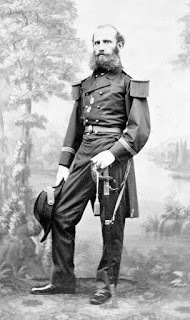
Tegetthoff
In the late 19th and early 20th Centuries the “K.u.K” – “Imperial and Royal” – Navy was probably the most efficient and well-equipped part of the Austro-Hungarian armed services. Operating out of bases on the Adriatic coast of what would later become Yugoslavia, and well provided with excellent ships, armed with the highly-regarded products of the Skoda arsenals in Bohemia, this navy was to represent a potent threat “in being” during World War 1 which tied up large Allied naval resources to contain it. The navy only became “Austro-Hungarian” in 1867 when the “Dual Monarchy” was formally established but the navy had existed since 1815 as the “Austrian Navy.” Its day of greatest glory was however almost a half-century before World War 1, when Austria-Hungary’s most famous admiral, Wilhelm von Tegetthoff (1827 –1871) led his fleet to an overwhelming victory over the Italians at Lissa in 1866. A daring and inspirational commander who was to die tragically young, Tegetthoff established a reputation in Austro-Hungarian popular consciousness which was comparable to that of Nelson in Britain. His success at Lissa was however preceded by a narrow tactical defeat two years earlier, not in the Austrian Navy’s normal operational area of the Adriatic and Mediterranean, but in the distant waters of the North Sea at the Battle of Heligoland 1864.
The Danish War of 1864 was to be the first of three conflicts deliberately instigated by Prussia’s chancellor, Otto von Bismarck, in the 1864 -1870 period to establish the primacy of Prussia over the other separate German Kingdoms and to unite them as a single empire under Prussian leadership. The ostensible reason for the war with Denmark was resolution of “The Schleswig-Holstein Question”, the control of two linguistically-German duchies lying directly south of modern Denmark and at that period under Danish control. The political, dynastic and diplomatic complexities of this “Question” were so impenetrable that the British Prime Minister, Lord Palmerston, was to quip that “Only three people have ever really understood the Schleswig-Holstein business—the Prince Consort, who is dead—a German professor, who has gone mad—and I, who have forgotten all about it.”
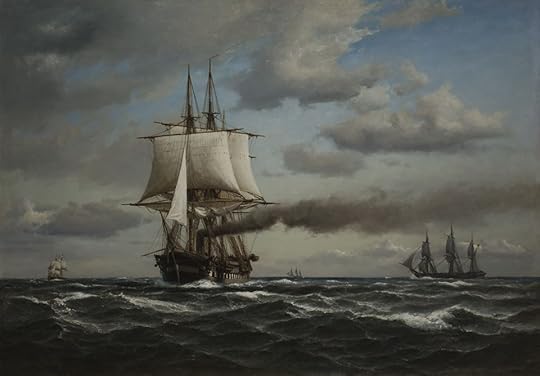 The Danish screw-frigate Jylland – wooden-hulled, steam and sail-driven, 44 guns
The Danish screw-frigate Jylland – wooden-hulled, steam and sail-driven, 44 guns
Though it was to put up a valiant defence, the small Kingdom of Denmark was to find itself heavily outnumbered and outgunned by the combined land forces of Prussia and Austria. The latter had allowed itself to be drawn into the conflict – stupidly as it was to find out two years later, when Prussia was to attack it in turn. It was only at sea that the Danes were to have a degree of superiority since it had a well-equipped and competent navy, whereas Prussia still had negligible naval forces – little more than a gunboat flotilla – and the more formidable Austrian Navy was operating far from its home bases in the Adriatic. The Danes were to use their resources effectively in support of land operations as well as imposing a blockade on Prussian ports.
[image error]
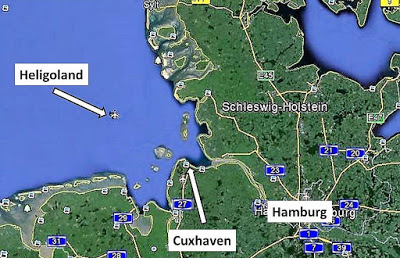 The most significant encounter of the short-duration (effectively February – May 1864) war was to occur close to its end, when significant naval forces clashed close to the then British-controlled island of Heligoland.
The most significant encounter of the short-duration (effectively February – May 1864) war was to occur close to its end, when significant naval forces clashed close to the then British-controlled island of Heligoland.
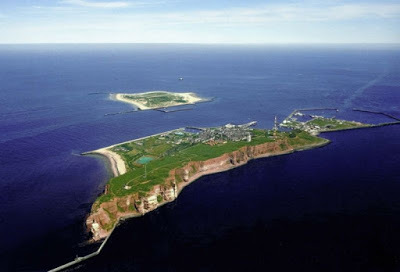 Heligoland – exchanged by Britain with Germany for Zanzibar in 1890
Heligoland – exchanged by Britain with Germany for Zanzibar in 1890
On May 9th a squadron of three powerful Danish vessels under the command of Admiral Edouard Suenson – the 42/44-gun screw frigates, Niels Juel and Jylland, supported by the 16-gun screw corvette Hejmdal – approaching from the north, sighted the neutral British frigate HMS Aurora on station off the island. Beyond her however, to the south-west, five other vessels came into view. These were the powerful Austrian screw frigates Schwarzenberg (51 guns) and Radetzky (37-guns), accompanied by three insignificant Prussian gunboats mounting three or for guns each. This squadron was under Tegetthoff’s overall command.
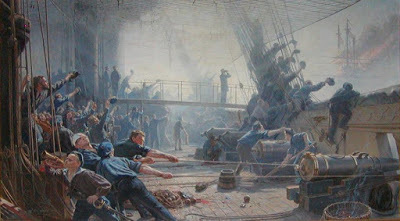 The Niels Juel in action – superb battle-painting by Christian Mølsted (1862-1930)
The Niels Juel in action – superb battle-painting by Christian Mølsted (1862-1930)
Both forces advanced to engage and at 13.15 hours the action commenced when Tegetthoff’s flagship, the Schwarzenberg, opened fire. This was returned by the Danes only when the range had shortened to a mile. An attempt by Tegetthoff to execute the classic “crossing the T” manoeuvre failed. Had it been successful it would have allowed his two vessels to concentrate their combined broadsides on the Danes’ lead ship. Instead, a Danish turn allowed the squadrons to pass each other in line. By this stage the three Prussian gunboats had fallen behind and Tegetthoff turned to prevent them being cut off by the Danes. This brought the opposing squadrons running south-westwards in two parallel lines. The Niels Juel concentrated her fire on the Schwarzenberg, while Jylland and Hejmdal directed theirs on the Radetzky.
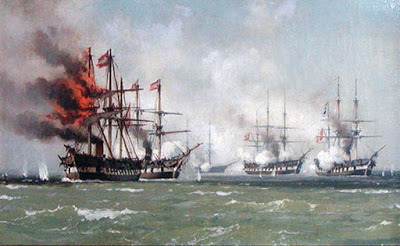 Schwartzenberg, burning, leading the Austrian line, Danish ships on right of painting
Schwartzenberg, burning, leading the Austrian line, Danish ships on right of painting
The action lasted for some two hours and culminated in the Schwarzenberg sustaining such serious damage that she took fire. With her loss a definite possibility, Tegetthoff decided to make for the neutral zone around Heligoland. The pursuit by the Danes had to be abandoned as the British Aurora, which had observed the action, was standing by to enforce neutrality if so needed. There was no option but to remain outside the three-mile limit while Tegetthoff managed to get the fire on the flagship under control. In the course of the following night he managed to evade the Danish squadron and bring his ships to the nearby Prussian-controlled port of Cuxhaven.
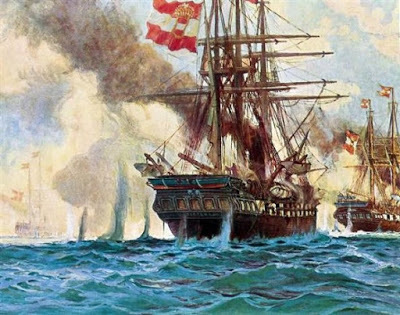 Radetsky following Schwartzenberg – painting by German naval artist Willy Kirchner
Radetsky following Schwartzenberg – painting by German naval artist Willy Kirchner
The action was generally judged to be – narrowly – a Danish tactical victory. The butcher’s bill had been small – 17 Danes killed and 37 wounded as compared with 37 dead and 93 wounded on the Austrian ships – though the losses would have been bitter indeed for the families of the men involved. Victory or defeat was irrelevant however. Three days later, on May 12th, an armistice was implemented which brought the fighting by land and by sea to an end. By the subsequent settlement Denmark lost control of the two duchies in contention and they were in due course incorporated into what became the German Empire. One was returned to Denmark after World War 1, a conflict in which the nation had been neutral.
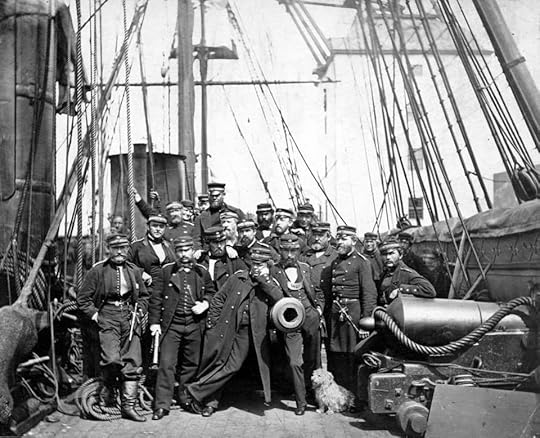 The Jylland’s officers after the battle (note the dog!)
The Jylland’s officers after the battle (note the dog!)
Denmark may have lost the war, but her resistance had been heroic and considerable national pride is still taken in it, justifiably so. The 2400-ton Jylland, one of the largest wooden warships ever built, and which had sustained major damage in the battle, has been preserved as a national monument. She is today on display in a dry dock at Ebeltoft.
This engagement off Heligoland was to prove the last major action before iron and steel replaced wood as the main construction material for ships. When Tegetthoff was to go into action again two years later – this time during a war which would pit Austria against its former ally Prussia, as well as against Italy – it was to be in a battle dominated by ironclads. On that occasion there would be no doubt as to who had gained victory, whether it tactical or strategic or both.
This war of 1864 is the background to Britannia’s Innocent, Start the 10-volume Dawlish Chronicles series of novels with the earliest chronologically of the Dawlish Chronicles 1864 – Political folly has brought war upon Denmark. Lacking allies, the country is invaded by the forces of military superpowers Prussia and Austria. Across the Atlantic, civil war rages. It is fought not only on American soil but also on the world’s oceans, as Confederate commerce raiders ravage Union merchant shipping as far away as the East Indies. And now a new raider, a powerful modern ironclad, is nearing completion in a British shipyard. But funds are lacking to pay for her armament and the Union government is pressing Britain to prevent her sailing. The Confederacy is willing to lease the new raider to Denmark for two months if she can be armed as payment, although the Union government is determined to see her sunk . . .
1864 – Political folly has brought war upon Denmark. Lacking allies, the country is invaded by the forces of military superpowers Prussia and Austria. Across the Atlantic, civil war rages. It is fought not only on American soil but also on the world’s oceans, as Confederate commerce raiders ravage Union merchant shipping as far away as the East Indies. And now a new raider, a powerful modern ironclad, is nearing completion in a British shipyard. But funds are lacking to pay for her armament and the Union government is pressing Britain to prevent her sailing. The Confederacy is willing to lease the new raider to Denmark for two months if she can be armed as payment, although the Union government is determined to see her sunk . . .
Just returned from Royal Navy service in the West Indies, the young Nicholas Dawlish volunteers to support Denmark. He is plunged into the horrors of a siege, shore-bombardment, raiding and battle in the cold North Sea – not to mention divided loyalties . . .
For more details, click below:For amazon.com For amazon.co.uk For amazon.com.au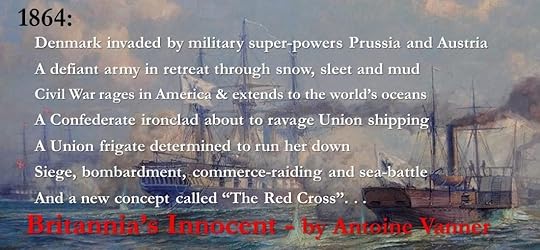
 The Dawlish Chronicles – now up to ten volumes, and ordering. Kindle Unlimited subscribers read at no extra charge.
The Dawlish Chronicles – now up to ten volumes, and ordering. Kindle Unlimited subscribers read at no extra charge.Six free short-stories are available for download to your Kindle. Access them by registering for the Dawlish Chronicles ma iling list – just click on the banner below. You’ll be kept updated on new books and will receive other free stories at intervals.
.fusion-body .fusion-builder-column-0{width:100% !important;margin-top : 0px;margin-bottom : 0px;}.fusion-builder-column-0 > .fusion-column-wrapper {padding-top : 0px !important;padding-right : 0px !important;margin-right : 1.92%;padding-bottom : 0px !important;padding-left : 0px !important;margin-left : 1.92%;}@media only screen and (max-width:1024px) {.fusion-body .fusion-builder-column-0{width:100% !important;}.fusion-builder-column-0 > .fusion-column-wrapper {margin-right : 1.92%;margin-left : 1.92%;}}@media only screen and (max-width:640px) {.fusion-body .fusion-builder-column-0{width:100% !important;}.fusion-builder-column-0 > .fusion-column-wrapper {margin-right : 1.92%;margin-left : 1.92%;}}.fusion-body .fusion-flex-container.fusion-builder-row-1{ padding-top : 0px;margin-top : 0px;padding-right : 20px;padding-bottom : 0px;margin-bottom : 0px;padding-left : 20px;}The post The Battle of Heligoland 1864 appeared first on dawlish chronicles.
August 19, 2022
The Chesapeake – HMS Leopard Incident, 1807
 The Chesapeake – HMS Leopard Incident, 1807
The Chesapeake – HMS Leopard Incident, 1807The three-year “War of 1812“between Britain and the United States, brought no great benefit to either nation. Though the issues involved were complex, one in particular, the British claim of the right to search neutral vessels for deserters from the Royal Navy, had the power to trigger American outrage and breathe new life into resentments that harked back to the War of Independence and before. Though it was not until 1812 that the United States declared war, the issue of recovering deserters had almost brought the two nations into conflict five years earlier, in what became known as the Chesapeake – Leopard Incident.
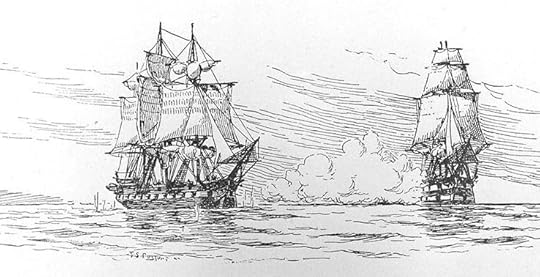
The action between HMS Leopard (r) and the USS Chesapeake (Drawing by Fred S. Cozzens)
In 1807 news reached the British base at Halifax, Nova Scotia, that several Royal Navy deserters had been accepted into service on the American frigate USS Chesapeake. In what might be considered an over-reaction, the station commander despatched the 50-gun frigate HMS Leopard, commanded by Captain Salusbury Pryce Humphreys (1778-1845), to bring orders to the captains of other vessels of the British squadron off the American coast. They were to insist on the right to search the Chesapeake for deserters should they fall in with her outside the territorial waters of the United States. In the event, it was HMS Leopard herself that was to make the demand.
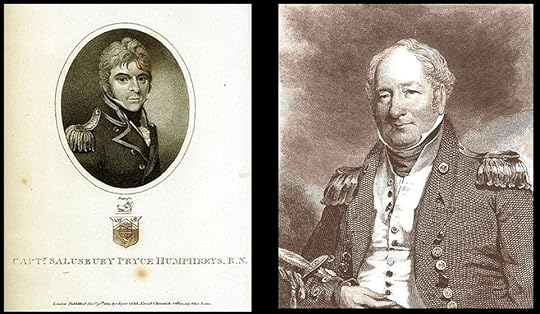
Humphreys and Barron – the two captains whose lives were to be changed by their encounter
Launched in 1785, the 50-gun fourth-rate HMS Leopard (fourth rates occupied an ambiguous position between frigates and ships-of-the-line) had had a useful but undistinguished career since the outbreak of the Revolutionary and Napoleonic Wars. (She was to have a fictional as well as an actual career before her loss by grounding in 1814, for Captain Jack Aubrey was to command her in Patrick O’Brian’s novel Desolation Island.)
[image error]
USS Chesapeake – one of the US Navy’s original “Six-Frigates”
Having delivered her despatches, HMS Leopard was lying with the rest of the British squadron off the Hampton Roads when the USS Chesapeake was sighted on June 1st 1807, en route to the Mediterranean. The squadron commodore signalled HMS Leopard to detain her. The American captain, James Barron (1768-1851), did not appear to sense anything untoward – both nations were at peace. When HMS Leopard hailed to say that she carried message from the British commander-in-chief, Barron, replied “Send it on board—I will heave to.” HMS Leopard’s first lieutenant went across and when the matter of deserters was raised Barron stated that he had no such men on board.
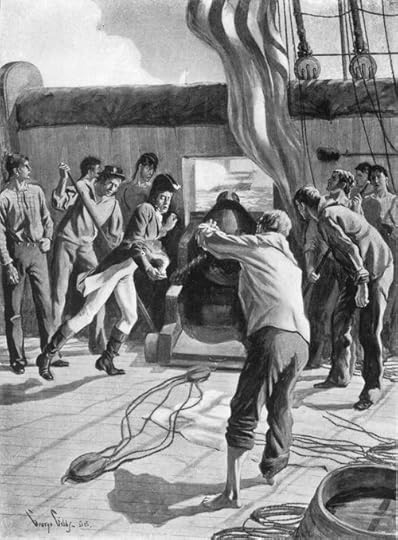
Chesapeake’s reply to Leopard
After the lieutenant had returned to the Leopard, Captain Humphries again hailed the Chesapeake. He did not consider the answer satisfactory and saw that there were signs of preparation for action on the American ship. To emphasise his demands he now ordered a shot to be fired across her bow. He continued firing at two-minute intervals. Increasingly frustrated by what he considered evasive answers from Barron, which he thought were only to gain time, he at last ordered fire to be opened in earnest. After receiving three broadsides, and after replying with only a few shots, the Chesapeake struck her colours. An American lieutenant came across with a verbal message from Barron, stating that he considered his ship to be HMS Leopard’s prize.
Captain Humphries did not accept the Chesapeake as a prize but he did send two of his lieutenants across, with several petty officers and men, to search for the deserters. One seaman, who was dragged out of the coal-hole, was recognised as Jenkin Ratford, a deserter from HMS Halifax. Three others were found, who had deserted from HMS Melampus, and about twelve more from various British warships. The first four were however to only ones to be brought across to the Leopard. Now – and quite bizarrely – Barron again offered to deliver up the Chesapeake as a prize. Captain Humphreys told him however that he had fulfilled his own instructions and that the American ship was free to proceed. He regretted having been compelled to attack and offered all the assistance in his power.
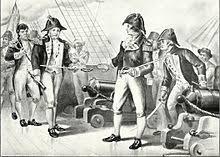
Barron tries to surrender USS Chesapeake as a prize
The Chesapeake had suffered severely from HMS Leopard’s broadsides. Twenty-two shot were lodged in her hull and her masts and rigging were badly damaged. She had lost three seamen killed, while Barron, one midshipman, and sixteen seamen and marines had been wounded. Since the Chesapeake was all but unready for battle, Barron’s unwillingness to continue the engagement was understandable if not necessarily heroic.
When HMS Leopard arrived at Halifax, the unfortunate Jenkin Ratford was found guilty of mutiny and desertion, and was hanged at the foreyard-arm of the ship from which he had deserted. The three other men, though found guilty of desertion, were initially sentenced to 500 lashes, but they had their sentence commuted and were later allowed to return to America.
It was inevitable that the Chesapeake-Leopard Affair would trigger outrage and demands for war in the United States. Protracted diplomatic negotiations failed to reach a mutually satisfactory outcome – Britain indeed reaffirmed its claim to right of impressment. As a sop to American feeling however, Captain Humphreys of HMS Leopard was given no further commands. The United States backed off from declaring war but President Thomas Jefferson resorted to economic warfare by means of a trade embargo that was aimed as much against France as against Britain.
The career of James Barron of the Chesapeake was also ruined. He was court-martialled in January 1808 on the charge of not having his ship ready for action and he was suspended for five years without pay. Though this ended in 1812, the Navy refused his requests to be accepted back for service during the war that began that year. One of the members of the court was Stephen Decatur (1779 –1820) and Barron appears to have held a grudge against him thereafter. Bad blood between the two men escalated to the extent of Barron challenging Decatur, now a national hero, to a duel with pistols in 1820. Both men were hit and badly wounded. As they were carried from the field Barron called out “God bless you, Decatur” and Decatur replied in a weak voice “Farewell, farewell, Barron.” Decatur died of his wound but Barron survived. It was a sad and futile postscript to the Leopard – Chesapeake affair.
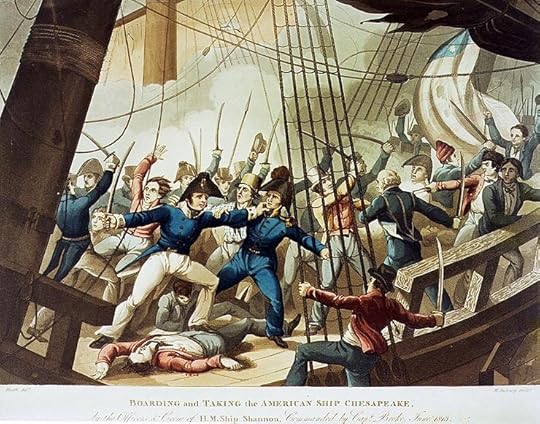
Contemporary print: HMS Shanon’s crew boarding USS Chesapeake in 1813
By that time USS Chesapeake herself was a thing of the past. She was captured by HMS Shannon after an epic duel on June 1st 1813, exactly six years after her encounter with HMS Leopard. Taken into Royal Navy service as HMS Chesapeake, was broken up in 1819. Some of her timbers are now incorporated in the structure of the Chesapeake Mill emporium in Wickham, Hampshire.
Naval fiction enters the Age of Fighting SteamBritannia’s Reach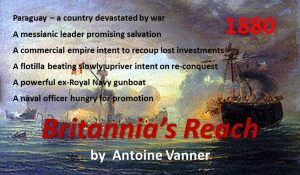 1881: On a broad river deep in the heart of South America, a flotilla of paddle steamers thrashes slowly upstream. Laden with troops, horses and artillery, intent on conquest and revenge.
1881: On a broad river deep in the heart of South America, a flotilla of paddle steamers thrashes slowly upstream. Laden with troops, horses and artillery, intent on conquest and revenge.
Ahead lies a commercial empire that was wrested from a British consortium in a bloody revolution. Now the investors are determined to recoup their losses and are funding a vicious war to do so.
Nicholas Dawlish, an ambitious British naval officer, is playing a leading role in the expedition. But as brutal land and river battles mark its progress upriver, and as both sides inflict and endure ever greater suffering, stalemate threatens.
And Dawlish finds himself forced to make a terrible ethical choice if he is to return to Britain with some shreds of integrity remaining . . .
For US – click hereFor UK – click hereFor Australia and New Zealand – click hereAnd, as always, Kindle Unlimited subscribers can read it at no extra cost. The Dawlish Chronicles – now up to ten volumes, and counting. Click on the banner above for details
The Dawlish Chronicles – now up to ten volumes, and counting. Click on the banner above for detailsSix free short-stories are available for download to your Kindle. Access them by registering for the Dawlish Chronicles ma iling list – just click on the banner below. You’ll be kept updated on new books and will receive other free stories at intervals.
.fusion-body .fusion-builder-column-0{width:100% !important;margin-top : 0px;margin-bottom : 0px;}.fusion-builder-column-0 > .fusion-column-wrapper {padding-top : 0px !important;padding-right : 0px !important;margin-right : 1.92%;padding-bottom : 0px !important;padding-left : 0px !important;margin-left : 1.92%;}@media only screen and (max-width:1024px) {.fusion-body .fusion-builder-column-0{width:100% !important;}.fusion-builder-column-0 > .fusion-column-wrapper {margin-right : 1.92%;margin-left : 1.92%;}}@media only screen and (max-width:640px) {.fusion-body .fusion-builder-column-0{width:100% !important;}.fusion-builder-column-0 > .fusion-column-wrapper {margin-right : 1.92%;margin-left : 1.92%;}}.fusion-body .fusion-flex-container.fusion-builder-row-1{ padding-top : 0px;margin-top : 0px;padding-right : 20px;padding-bottom : 0px;margin-bottom : 0px;padding-left : 20px;}The post The Chesapeake – HMS Leopard Incident, 1807 appeared first on dawlish chronicles.
August 4, 2022
Battle of Ushant 1778 – its farcical aftermath, the guillotine and a “Citizen King”
 The indecisive Battle of Ushant 1778 – and its farcical aftermath, the guillotine and a “Citizen King”
The indecisive Battle of Ushant 1778 – and its farcical aftermath, the guillotine and a “Citizen King”France’s entry into the American War of Independence was to prove a critical factor is assuring the survival of the United States. It did so by winning the only strategically-significant victory in all French naval history – that off the Virginia Capes in 1781, which starved British forces at Yorktown of supplies and made their surrender unavoidable. The unforeseen cost to the French monarchy of supporting this upstart republic founded on democratic principles was however to be enormous. French officers returned from America with the conviction that France’s governmental system was rotten and unsustainable. Once that fact was widely recognised revolution was inevitable and the whole bloody process would commence in 1789. The opening event in the sequence, the Battle of Ushant 1778, was to have a farcical aftermath and be the first step towards the guillotine for one of the main players, and to the throne of France for his son.
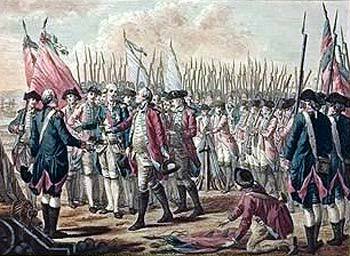
The British surrender at Yorktown – made inevitable by a French naval victory
The driver for France’s involvement in the war was the adage that “My enemy’s enemy is my friend” (an often-dangerous assumption, as it was in this case) and the objective was to strike at Britain, the old enemy with which she had fought a long sequence of wars over the hundred years. France’s supply of arms to the American rebels and her formal recognition of the United States in February 1778 made it inevitable that Britain would declare war on France in the following month. The initial confrontations had to be naval, since control of sea routes to and from North America was essential for both sides.
 Bien-Aimé, typical 74, in First Division of French White Squadtron at Ushant, by François Roux
Bien-Aimé, typical 74, in First Division of French White Squadtron at Ushant, by François Roux
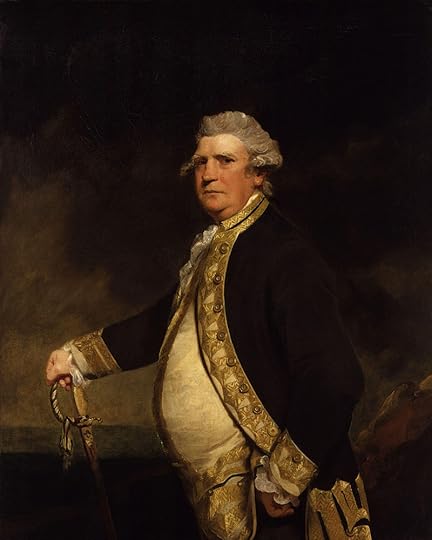
Admiral Keppel by Sir Joshua Reynolds
France possessed a fleet in the Mediterranean and a second, based at Brest in Brittany, to operate in Atlantic and Channel waters. An important strategic decision for Britain was concentrating its resources in the Channel Fleet so as to blockade French forces at Brest. By doing so, attacks on merchant shipping to and from Britain, and any French attempt at mounting an invasion, could be countered. The situation changed however when a French naval force slipped out of the Mediterranean and headed for the Americas. There was no option but to detach forces from the Channel Fleet to follow this force. This still left the French and British navies in rough numeric balance in and off Brest and made a French break-out more feasible.
The Royal Navy’s Channel Fleet was commanded by Admiral Augustus Keppel (1725 – 1786), who can be described as competent but not brilliant. Like many officers of the era he had a parallel political career as a Member of Parliament and bad blood existed between him, as a committed Whig, and the First Lord of the Admiralty, the Navy’s professional head and a dedicated member of the opposing group known as “The King’s Friends”. The depth of bitterness was such that Keppel feared that the First Lord would be glad for him to be defeated. Further bad feeling existed between Keppel and one of his subordinate admirals, Sir Hugh Palliser (1723–1796), another politically active officer and previously a member of the Admiralty Board, which Keppel blamed for the running down of the Royal Navy in the aftermath of the Seven Years War. These personal enmities did not bode well for mutual trust and cooperation in the heat of battle.
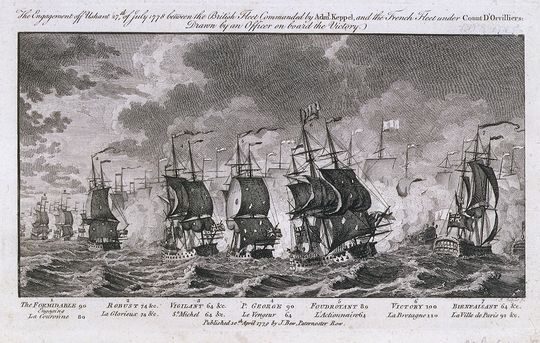
British line at Ushant: HMS Foudroyant, identified in print block third from right, was captained by Sir John Jervis, later Viscount St. Vincent
The clash – the first major naval action of the war – came on 23rd July some 100 miles west of Ushant, a small island off the coast of Brittany. The numbers of ships on both sides were large and all but equal. The British force consisted of 29 ships of the line and faced 30 similar French ships and two smaller ones. The French held the weather-gage – that is, they were upwind of their opponents, a usually critical advantage in the age of Sail – but this was largely nullified by the orders given to the French commander, Admiral Comte d’Orvilliers (1708 – 1792) to avoid battle. (The concept of “a fleet in being” had existed since the late 17th Century). The result was to pit two fleets against each other, one of which had a less than unified command while the other was commanded by an admiral who was instructed not to fight.

Battle of Ushant by Theodore Guediin, painted circa 1848
Note British and French lines passing on opposite tacks
Shifting winds and a heavy rain squall made weather conditions unfavourable as the British force manoeuvred to bring itself parallel to the French, and on the same course, while maintaining a less-than perfect column – inevitable under the circumstances. The French objective was however to escape rather than give battle. Wearing – a reversal of course – brought the French on an opposite course and still to windward. Fire was opened and the head of the British column – led by HMS Victory, whose greatest triumph was still 27 years in the future – sustained little damage but the rearmost division, commanded by Admiral Palliser, was battered more heavily as the French passed. Keppel signalled for the British column to wear so as to follow the French. For whatever reason, Palliser to not comply. The result was that the French fleet escaped. Neither side had lost a ship but the butcher’s bill was heavy nonetheless. The British lost 407 men killed and 789 wounded while the corresponding figures for the French were 126 and 413.
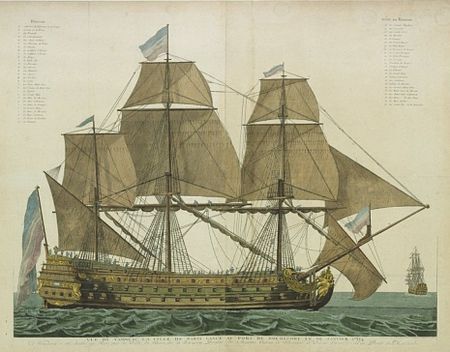 The massive 90-gun Ville de Paris was present at Ushant, but was captured by Britain in 1782
The massive 90-gun Ville de Paris was present at Ushant, but was captured by Britain in 1782
Bitter recriminations followed on both sides. Keppel praised Palliser in his official report but staged a campaign against him with the support of the Whig press. Palliser responded in kind such that both men all but accused each other of treason. This led to both Keppel and Palliser being court-martialled, both being acquitted, though Palliser was censured. Keppel’s political cronies ensured that he became in due course an undistinguished First Lord of the Admiralty while Palliser’s career continued with no great distinction. The whole affair had done nothing for the morale of the service or for the good of the country.

d’Orleans a.k.a. “Philippe Égalité”
The aftermath of the battle on the French side had more of farce than of drama about it. One of the officers serving in d’Orvilliers’ fleet was Louis Philippe d’Orléans, Duc de Chatres (1747 – 1793), who belonged to a junior branch of the Bourbon family and thus a relative of the reigning King Louis XVI. He was to be better known to history as “Philippe Égalité” but that lay in the future when he was despatched to the Palace of Versailles with news of the battle. He arrived in the early morning hours, had the king woken, and provided a highly coloured account that represented the action as a French victory. The news spread and when Louis Philippe attended the opera he was greeted with a twenty-minute standing ovation. This was followed up by burning of Keppel’s effigy in the garden of Louis Philippe’s home in the Palais Royale. Glowing with pride after this reception, he returned to Brest only to find that more accurate accounts were now being issued which made it very plain that there had been no victory. Deeply embarrassed, and quickly made a figure of ridicule, he had no option but to resign from the navy. He succeeded to the title of Duc d’Orleans in 1785 and was now next in line to succeed to the throne should the direct royal line die out. He thereafter got embroiled in bitter enmity and mutual loathing with Queen Marie-Antoinette. She regarded him as treacherous and hypocritical, and he regarded her as frivolous and extravagant. (Both assessments were essentially correct).
In the years leading up to the revolution that would break out in 1789 d’Orleans allied himself with the movement for reform, reinforcing the anti-royalist image he had had for some time. This might be regarded as an early example of “radical chic” and d’Orleans made his residence, the Palais Royale, available for meetings of the extremist Jacobin Club. He gained sufficient popularity that when the Paris mob invaded the Palace of Versailles in October 1789 the cry was heard of “Long live our King d’Orléans!” In the four years of revolution that followed, a bewildering period of upheaval and shifting alliances, d’Orleans renounced his titles to become Citizen Philippe Égalité (Equality) and a member of the Constituent Assembly. When King Louis XVI was put on trial for his life in January 1793, Philippe Égalité to voted for his cousin’s execution.

Execution of Louis VVI, January 1793 – Philippe Égalité voted for it
He died himself on the same scaffold ten months later
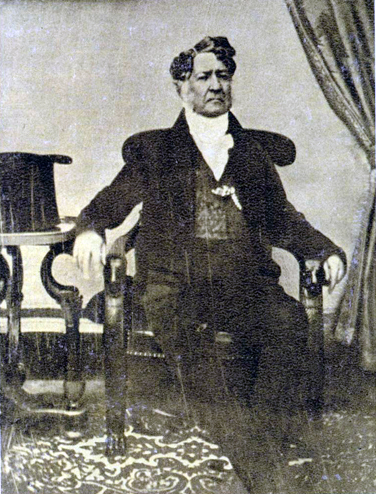
“Citizen King” Louis Philippe in 1842
For all his identification with republican ideals, Philippe Égalité was not however to survive long in the snake-pit of revolutionary turmoil. As the Reign of Terror took hold he was to be another of those consumed by the revolution they had brought about. He went to the guillotine in November 1793, doing so however with dignity and calmness that did him credit.
Philippe Égalité, had he lived to know it, had the last laugh. The Second French Revolution, in 1830, brought his son (1773 – 1850) to the throne as King Louis-Philippe I, who reigned as “The Citizen King” for eighteen years until a Third Revolution, in 1848, deposed him. He lived out his last years once again in exile in England, where he had previously spent the years 1793-1815. His daughter Louise married Leopold, first King of the Belgians in 1832, so that Philippe Égalité’s bloodline runs on today through the monarch who reigns today in Brussels.
It all seems far removed from the farcical aftermath of the Battle of Ushant 1778. One wonders however whether the 533 men killed and the hundreds wounded in it would have appreciated the ironies.
Britannia’s Innocent: The first chronologically of the Dawlish Chronicles Series:In which we meet the 19-year old Nicholas Dawlish on the threshold of promotion to Sub-Lieutenant …
 1864 – Political folly has brought war upon Denmark. Lacking allies, the country is invaded by the forces of military superpowers Prussia and Austria. Across the Atlantic, civil war rages. It is fought not only on American soil but also on the world’s oceans, as Confederate commerce raiders ravage Union merchant shipping as far away as the East Indies. And now a new raider, a powerful modern ironclad, is nearing completion in a British shipyard. But funds are lacking to pay for her armament and the Union government is pressing Britain to prevent her sailing. The Confederacy is willing to lease the new raider to Denmark for two months if she can be armed as payment, although the Union government is determined to see her sunk . . .
1864 – Political folly has brought war upon Denmark. Lacking allies, the country is invaded by the forces of military superpowers Prussia and Austria. Across the Atlantic, civil war rages. It is fought not only on American soil but also on the world’s oceans, as Confederate commerce raiders ravage Union merchant shipping as far away as the East Indies. And now a new raider, a powerful modern ironclad, is nearing completion in a British shipyard. But funds are lacking to pay for her armament and the Union government is pressing Britain to prevent her sailing. The Confederacy is willing to lease the new raider to Denmark for two months if she can be armed as payment, although the Union government is determined to see her sunk . . .
Just returned from Royal Navy service in the West Indies, the young Nicholas Dawlish volunteers to support Denmark. He is plunged into the horrors of a siege, shore-bombardment, raiding and battle in the cold North Sea – not to mention divided loyalties . . .
For more details, click below:For amazon.com For amazon.co.uk For amazon.com.auAs with all Dawlish Chronicles novels, Kindle Unlimited subscribers can read it at no extra cost.
 The Dawlish Chronicles – now up to ten volumes, and counting. Click on the banner above for more details
The Dawlish Chronicles – now up to ten volumes, and counting. Click on the banner above for more detailsSix free short stories are available for download to your Kindle. Access them by registering for the Dawlish Chronicles ma iling list – just click on the banner below. You’ll be kept updated on new books and will receive other free stories at intervals.
.fusion-body .fusion-builder-column-0{width:100% !important;margin-top : 0px;margin-bottom : 0px;}.fusion-builder-column-0 > .fusion-column-wrapper {padding-top : 0px !important;padding-right : 0px !important;margin-right : 1.92%;padding-bottom : 0px !important;padding-left : 0px !important;margin-left : 1.92%;}@media only screen and (max-width:1024px) {.fusion-body .fusion-builder-column-0{width:100% !important;}.fusion-builder-column-0 > .fusion-column-wrapper {margin-right : 1.92%;margin-left : 1.92%;}}@media only screen and (max-width:640px) {.fusion-body .fusion-builder-column-0{width:100% !important;}.fusion-builder-column-0 > .fusion-column-wrapper {margin-right : 1.92%;margin-left : 1.92%;}}.fusion-body .fusion-flex-container.fusion-builder-row-1{ padding-top : 0px;margin-top : 0px;padding-right : 20px;padding-bottom : 0px;margin-bottom : 0px;padding-left : 20px;}The post Battle of Ushant 1778 – its farcical aftermath, the guillotine and a “Citizen King” appeared first on dawlish chronicles.
July 24, 2022
HMS Royal George Salvage
 The salvage of HMS Royal George, 1782 – 1844
The salvage of HMS Royal George, 1782 – 1844
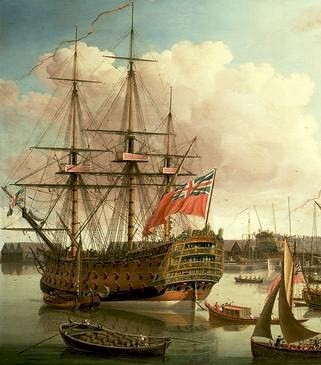
HMS Royal George in her glory
The loss, while at anchor at Spithead, off Portsmouth, of the ship-of-the-line HMS Royal George on August 29th 1782 was a disaster that had an impact on British society comparable to the loss of RMS Titanic one hundred and thirty years later. The catastrophe was described in an earlier article on this site (click here to read it if you missed it then). The sinking was not however the end of the story and the salvage of HMS Royal George, which was to be completed six decades later, was to be an epic in itself and to make innovative use of new diving technology.
Lying as she was in only sixty-five feet of water, in the middle of a busy anchorage and the approaches to Britain’s largest naval base, this enormous vessel, largely intact, represented a major hazard. The sinking had been witnessed by a surgeon on an East Indiaman, Thomas Spalding, whose brother, Charles Spalding (1738 – 1783) already had experience of using diving bells for salvage operations.
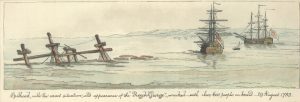
HMS Royal George in the aftermath of her sinking,
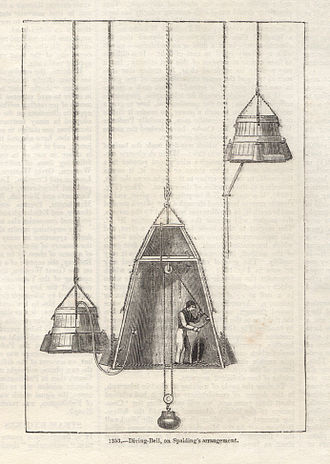 Charles Spalding’s Bell – the two smaller bells seemed to have been used for bringing fresh air supplies to the main bell. Note tube running to it from the small bell on the left
Charles Spalding’s Bell – the two smaller bells seemed to have been used for bringing fresh air supplies to the main bell. Note tube running to it from the small bell on the left
Innovative and courageous, Charles originally a confectioner with a shop in Edinburgh, had made significant safety and operational improvements to existing bell designs. Large enough to accommodate two men, and with glass windows to provide light, Spalding’s bell was lowered by a counterweight system – which allowed fast recovery – and had a rope-based signalling system. Thomas Spalding immediately saw that the wreck of HMS Royal George could be an opportunity for his brother. He therefore suggested to the Admiralty that they could recover valuable stores and weapons from her wreck.
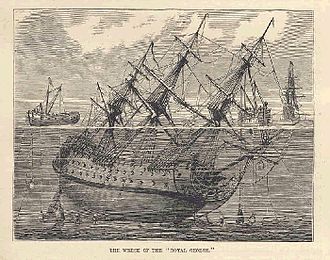 Work in progress by the Spaldings – note bells, for which working on the hull was difficult
Work in progress by the Spaldings – note bells, for which working on the hull was difficult
Having gained agreement, the Spaldings got to work quickly. In little over a month – most of October and early November – and despite poor weather, they managed to raise fifteen guns, for which the Admiralty paid £400. It is remarkable that the Spaldings achieved as much as they did – the bell was unsuitable for working on a large object that rose well clear of the seabed. (see illustration) There does however appear to have been a substantial amount of debris on the ground – it is easy to imagine heavy items like cannon breaking free as HMS Royal George heeled over. The Spaldings might have returned to the work after the winter had another, and potentially a more lucrative, opportunity arise. This was the sinking of the East-Indiaman Count de Belgioso on the Kish Bank, outside Dublin. She had been carrying silver and lead – salvage of even a part would have been vastly profitable. In the event the effort proved disastrous – in June 1783 Charles Spalding and a worker with him died in the bell and operations ceased.
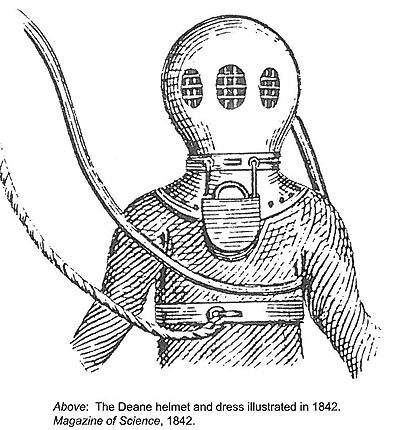
Deane helmet, 1842
The next attempt at salvage had to wait until 1834. By then the first and rudimentary first air-pumped diving helmets had become available, invented by the brothers Deane, Charles Anthony (1796-1848) and John (1800 – 1884). For them too, the Royal George wreck represented an opportunity. By this time the hull had partly disintegrated, making it possible to recover more from the debris. The brothers worked for two years, 1834-36, recovering a total of twenty-eight guns. It proved impossible to reach any more as they were buried beneath mud and shattered hull-timbers. It was during this time that the Deans were asked by local fishermen to investigate another wreck close by that was damaging their nets. The brothers did so and thereby located the Mary Rose, Henry VIII’s flagship that had been lost in 1545. (Sections of the Mary Rose’s hull are on display today at the Portsmouth dockyard).
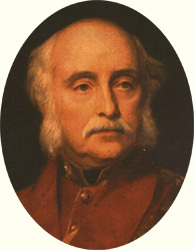
Sir Charles Pasley
The final, and most complete, salvage effort came in 1839 and was to last until 1844. The work was entrusted to the army’s Corps of Royal Engineers under the direction of Colonel (and later General) Charles Pasley (1780-1861). He was systematic, thorough and persistent. Basing his plans on previous demolition of wrecks in the Thames estuary by explosive charges, he determined to blast the remained of HMS Royal George’s hull apart, step by step, and pick up the resulting debris. He had the advantage of air-pumped diving helmets – as developed by the Deanes – as well as having a team of disciplined men as divers. Significant technical progress was also made in underwater blasting. The initial approach was to use gunpowder packed in wooden barrels and sheathed with lead, the detonators being chemical fuses. Given the uncertainty as to how long such detonators would take to explode, placing these charges must have been nerve-racking. Copper cylinders were used later, with electrically-triggered detonation. This allowed a number of such charges to be placed around the wreck and detonated simultaneously from a distance. The largest of the explosions, in 1840, that which finally smashed the remainder of the hull to fragments, was powerful enough to shatter windows in nearby Portsmouth. A total of thirty cannon were recovered, as well as other ironwork, but the chief objective was the removal of the debris as a shipping hazard. An account written in 1877 indicated that the divers were frequently “six to eight hours a day underwater” – if true, it was appalling labour. It was noted that “by long experience they had come to economise time and effort in so skilful a manner, that all of them sent up to the boats in attendance on them their bundles of staves, casks or timber as closely packed together as a woodman would make up his faggots in the open air.”
When Pasley’s team finished work in 1844, the seabed was at last clear of the remains of HMS Royal George, a ship that had proudly flown the flag of Admiral Lord Hawke at the Battle of Quiberon Bay in 1759. Sic transit…
Britannia’s Innocent: The first chronologically of the Dawlish Chronicles Series:Typical 5-star review on Amazon, named “The most thoughtful Naval adventure series, ever.““Each of the Dawlish Chronicles is better than the last. Combines the action and adventure of Tom Clancy or Bernard Cornwell, with the sensibility of Henry James or Jack London. The hero perseveres in the face of adversity and remains true to his principles and evolving moral sensibilities: becoming more complete with each challenge. Not jingoistic, but a determined ethical man, who will fulfil his duty to the ends of the earth. I can’t wait for the next novel in this series! Thank you Mr Vanner for this fabulous hero placed so aptly into a backdrop of eminent Victorians.”
For more details, click below:For amazon.com For amazon.co.uk For amazon.com.auAs with all Dawlish Chronicles novels, Kindle Unlimited subscribers can read it at no extra cost.
 The Dawlish Chronicles – now up to ten volumes, and counting. Click on the banner above for more details
The Dawlish Chronicles – now up to ten volumes, and counting. Click on the banner above for more detailsSix free short stories are available for download to your Kindle. Access them by registering for the Dawlish Chronicles ma iling list – just click on the banner below. You’ll be kept updated on new books and will receive other free stories at intervals.
.fusion-body .fusion-builder-column-0{width:100% !important;margin-top : 0px;margin-bottom : 0px;}.fusion-builder-column-0 > .fusion-column-wrapper {padding-top : 0px !important;padding-right : 0px !important;margin-right : 1.92%;padding-bottom : 0px !important;padding-left : 0px !important;margin-left : 1.92%;}@media only screen and (max-width:1024px) {.fusion-body .fusion-builder-column-0{width:100% !important;}.fusion-builder-column-0 > .fusion-column-wrapper {margin-right : 1.92%;margin-left : 1.92%;}}@media only screen and (max-width:640px) {.fusion-body .fusion-builder-column-0{width:100% !important;}.fusion-builder-column-0 > .fusion-column-wrapper {margin-right : 1.92%;margin-left : 1.92%;}}.fusion-body .fusion-flex-container.fusion-builder-row-1{ padding-top : 0px;margin-top : 0px;padding-right : 20px;padding-bottom : 0px;margin-bottom : 0px;padding-left : 20px;}The post HMS Royal George Salvage appeared first on dawlish chronicles.
July 7, 2022
Training Tragedies – HMS Eurydice & HMS Atalanta
 Training Tragedies: the losses ofHMS Eurydice and HMS Atalanta
Training Tragedies: the losses ofHMS Eurydice and HMS Atalanta[image error]

At first glance, the picture of a frigate such as HMS Eurydice, as above, immediately evokes visions of single-ship actions of the Napoleonic period. It is therefore all the more surprising that this ship was still in service in 1878 and that her destruction was witnessed by the young Winston Churchill who would live on to oversee development of Britain’s nuclear deterrent. HMS Eurydice’s story, and that of her successor, HMS Atalanta, are some of the most tragic ever to occur in peacetime service in the Royal Navy.
This begs the question of “Why were such vessels still in service when steam was already established as the most reliable and efficient method of propulsion?”
[image error]
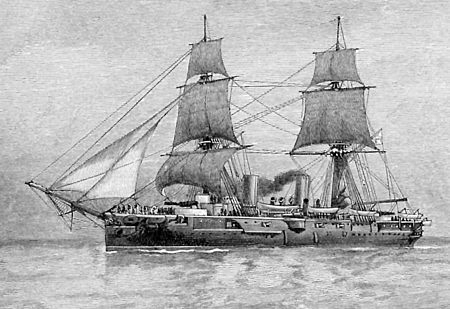 Armoured-cruiser HMS Warspite of 1884 – her sailing rig was removed
Armoured-cruiser HMS Warspite of 1884 – her sailing rig was removed
early in her career and she served thereafter under steam power only
[image error]
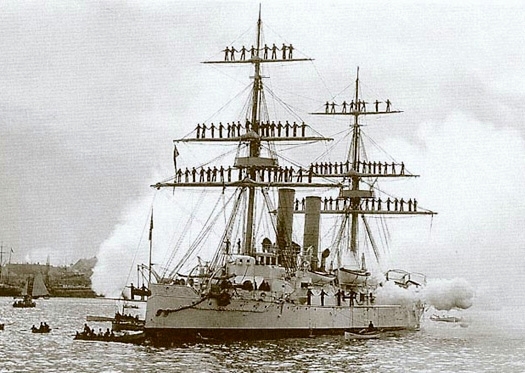 Not only the Royal Navy retained sailing rigs.
Here is the American protected cruiser USS Atlanta of 1884
Not only the Royal Navy retained sailing rigs.
Here is the American protected cruiser USS Atlanta of 1884
The answer is that warships in all navies carried sail as well as steam power right up to the end of the 19th Century. Boilers were still inefficient, though improving, and their furnaces were ravenous for coal. For long-distance cruising, away from easy coal supply, retention of sail made sense, even though the presence of masts and yards was likely to be a major point of vulnerability in combat. As innovations in boiler and engine design improved efficiency, and reduced coal demand, the need for sail decreased. In the 1880s sailing rigs were phased out for major vessels but even thereafter retention continued to make sense through the 1890s for smaller craft on remote stations. Typical examples were small, slow gunboats such as those of the Redbreast class, powerfully armed with six 4-inch breech-loaders and ideal for colonial service.
[image error]
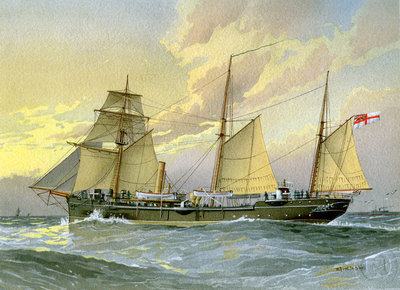 HMS Thrush – a Redbreast class gunboat of 1889
HMS Thrush – a Redbreast class gunboat of 1889
Training of officers and men in managing sail as well as steam was therefore of the utmost importance. For many years after steam had replaced sail for all operational purposes there was a strong body of opinion remained that mastery of sail, and of “work aloft”, was essential for character-building, even when this meant training on masts set up on land.
This is the background to the retention of HMS Eurydice as a Royal Navy training ship. She had been built in 1843 as a very fast 26-gun frigate designed with a very shallow draught to operate in coastal waters. Wholly sail-dependent, her design and armament were little different to those of the frigates commanded by captains such as Pellew and Cochrane some four decades earlier. Over the next eighteen years she saw service worldwide, including an uneventful assignment to the White Sea during the Crimean War. She was converted to a stationary training ship in 1861 and remained in this role until re-commissioned as a sea-going vessel in 1877. HMS Eurydice departed on a three-month training cruise to the West Indies in the November of that year, carrying 319 crew and trainees.
 Contemporary artist’s impression of HMS Eurydice capsizing
Contemporary artist’s impression of HMS Eurydice capsizing
The cruise appears to have been uneventful. A fast, 18-day, voyage from Bermuda brought HMS Eurydice back to the Isle of Wight by March 24th 1878 prior to entering Portsmouth. At this point she was engulfed in a heavy snow storm and capsized and sank. There were only two survivors as those not brought down in the ship itself died of exposure in the freezing water. Her captain, Captain Marcus Hare, went down with his ship after ordering every man to save himself and then clasping his hands in prayer. The wreck was in shallow enough water for the masts to protrude and it was refloated later in the year. It is not surprising however that this old wooden vessel was past repair and she was accordingly broken up. The subsequent enquiry held her officers and crew blameless and found that the disaster had been caused stress of weather. There was however some concern expressed on the suitability of HMS Eurydice as a training ship because of known concerns as to her stability.
 The remains of HMS Eurydice, as Churchill remembered her over five decades later
The remains of HMS Eurydice, as Churchill remembered her over five decades later
Winston Churchill, who was four at the time, was at Ventnor on the Isle of Wight and he witnessed the tragedy. It obviously made a lasting impression on him, as he recounted fifty-two years later in his memoir “My Early Life”:
“One day when we were out on the cliffs near Ventnor, we saw a great splendid ship with all her sails set, passing the shore only a mile or two away… Then all of a sudden there were black clouds and wind and the first drops of a storm, and we just scrambled home without getting wet through. The next time I went out on those cliffs there was no splendid ship in full sail, but three black masts were pointed out to me, sticking up out of the water in a stark way… The divers went down to bring up the corpses. I was told and it made a scar on my mind that some of the divers had fainted with terror at seeing the fish eating the bodies… I seem to have seen some of these corpses towed very slowly by boats one sunny day. There were many people on the cliffs to watch, and we all took off our hats in sorrow.”
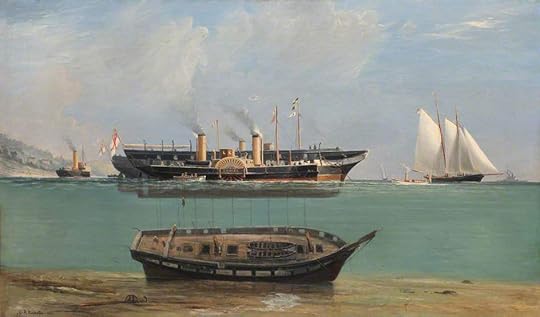
Contemporary illustration of salvage efforts.
Note diver (tiny dot) being lowered towards the quarterdeck
 Salvage operations in progress
Salvage operations in progress
The poet Gerald Manley Hopkins was sufficiently moved by the tragedy to write very powerfully on “The Loss of the Eurydice”. Space precludes copying his poem in full here but the following verses are especially memorable:
They say who saw one sea-corpse cold
He was all of lovely manly mould,
Every inch a tar,
Of the best we boast our sailors are.
Look, foot to forelock, how all things suit! he
Is strung by duty, is strained to beauty,
And brown-as-dawning-skinned
With brine and shine and whirling wind.
O his nimble finger, his gnarled grip!
Leagues, leagues of seamanship
Slumber in these forsaken
Bones, this sinew, and will not waken.
It is normal – today more than ever – to state solemnly after every disaster that “Lessons have been learned” though in practice this seldom seems to happen. This was especially the case in the aftermath of the Eurydice catastrophe. The Admiralty proceeded to replace her with HMS Juno, another 26-gun frigate of identical tonnage but slightly less radical hull-lines, built in 1844. She was renamed HMS Atalanta and she made two successful training cruises to the West Indies before disappearing at sea in 1880 with the loss of all 281 crew and trainees while en route from Bermuda to Britain. It was presumed that she sank in a powerful storm which crossed her route a couple of weeks after she sailed. A gunboat HMS Avon did however report that near the Azores “she noticed immense quantities of wreckage floating about… in fact the sea was strewn with spars etc.”
 HMS Atalanta
HMS Atalanta
Investigation of the disaster was hampered by lack of evidence but a former crew member stated that “she rolled 32 degrees, and Captain Stirling is reported as having been heard to remark that had she rolled one degree more she must have gone over and foundered. The young sailors were either too timid to go aloft or were incapacitated by sea-sickness.” The witness added that many “hid themselves away” in such circumstances and “could not be found when wanted by the boatswain’s mate.”
The most devastating verdict on the disaster was delivered by The Times, then at the height of its prestige. It denounced “the criminal folly of sending some 300 lads who have never been to sea before in a training ship without a sufficient number of trained an experienced seamen to take charge of her in exceptional circumstances. The ship’s company of the Atalanta numbered only about 11 able seamen, and when we consider that young lads are often afraid to go aloft in a gale to take down sail… a special danger attaching to the Atalanta becomes apparent.”
Both tragedies – claiming 600 lives in two years – shook public confidence in the Royal Navy. A new breed of professional was however emerging, men who understood the demands and opportunities of new technology. Chief among these officers was to be Sir John Fisher, later Lord Fisher, who would create the Dreadnought navy that Britain took into World War 1. It is therefore all the more ironic that one of the officers to lose his life on HMS Atalanta was his younger brother, Lieutenant Phillip Fisher.
 HMS Eurydice under sail
HMS Eurydice under sail
Click image for details or to order
1883: The slave trade flourishes in the Indian Ocean, a profitable trail of death and misery leading from ravaged African villages to the insatiable markets of Arabia. Britain is committed to its suppression but now there is pressure for more vigorous action . . .
Two Arab sultanates on the East African coast control access to the interior. Britain is reluctant to occupy them but cannot afford to let any other European power do so either. But now the recently-established German Empire is showing interest in colonial expansion . . .
With instructions that can be disowned in case of failure, Captain Nicholas Dawlish must plunge into this imbroglio to defend British interests. He’ll be supported by the crews of his cruiser HMS Leonidas, and of a smaller warship. But it’s not going to be so straightforward . . .
Getting his fighting force up a shallow, fever-ridden river to the mission is only the beginning for Dawlish. Atrocities lie ahead, battles on land and in swamp also, and strange alliances must be made.
And the ultimate arbiters may be the guns of HMS Leonidas and those of her counterpart from the Imperial German Navy.
In Britannia’s Mission Nicholas Dawlish faces cunning, greed and limitless cruelty. Success will be elusive . . . and perhaps impossible.
Click below for details or to order:For US & CanadaFor UK and IrelandFor Australia & New ZealandThe Dawlish Chronicles – now up to ten volumes, and counting. Click on the banner below for more detailsSix free short-stories are available for download to your Kindle. Access them by registering for the Dawlish Chronicles ma iling list – just click on the banner below. You’ll be kept updated on new books and will receive other free stories at intervals.
.fusion-body .fusion-builder-column-0{width:100% !important;margin-top : 0px;margin-bottom : 0px;}.fusion-builder-column-0 > .fusion-column-wrapper {padding-top : 0px !important;padding-right : 0px !important;margin-right : 1.92%;padding-bottom : 0px !important;padding-left : 0px !important;margin-left : 1.92%;}@media only screen and (max-width:1024px) {.fusion-body .fusion-builder-column-0{width:100% !important;}.fusion-builder-column-0 > .fusion-column-wrapper {margin-right : 1.92%;margin-left : 1.92%;}}@media only screen and (max-width:640px) {.fusion-body .fusion-builder-column-0{width:100% !important;}.fusion-builder-column-0 > .fusion-column-wrapper {margin-right : 1.92%;margin-left : 1.92%;}}.fusion-body .fusion-flex-container.fusion-builder-row-1{ padding-top : 0px;margin-top : 0px;padding-right : 20px;padding-bottom : 0px;margin-bottom : 0px;padding-left : 20px;}The post Training Tragedies – HMS Eurydice & HMS Atalanta appeared first on dawlish chronicles.
June 30, 2022
HMS Venerable, 1804
 Cool Heads in Crisis: HMS Venerable, 1804
Cool Heads in Crisis: HMS Venerable, 1804The Revolutionary and Napoleonic Wars locked Britain and France into almost twenty-two years of continuous war from 1793 and conflict at sea was a critical part of this. What is surprising however is how few ships were actually destroyed in combat. Whether in large fleet actions or in “single ship” duels, wooden ships tended to survive very heavy damage and could often be repaired sufficiently at sea to get them to port. When captured, such ships were often to get a new lease of life in the victor’s navy. Little use was made of explosive projectiles and though solid shot could inflict severe structural injury above the water-line, it seldom caused outright sinking. The relatively few ships that were lost due to combat mainly succumbed to magazine explosion, or to burning.
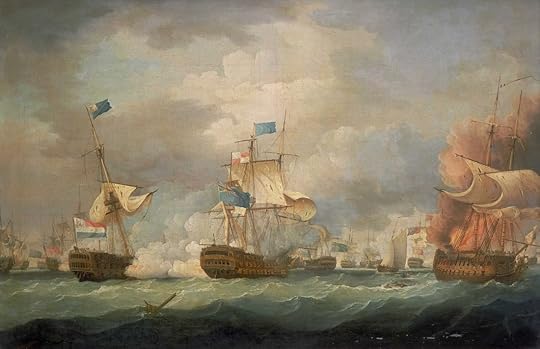
Camperdown, 1797 – one of the few fleet actions of the Revolutionary and Napoleonic Wars
Painting by Thomas Whitcombe (1763 – 1824 ) – Venerable at centre engaging Vrijheid on left
The greatest threat to a wooden warship’s survival came from stormy weather, especially if it were to be cast on a lee shore, where it could be battered to matchwood. One such loss occurred in 1804 when a Royal Navy “74”, HMS Venerable, encountered disaster. Built in 1784, HMS Venerable had played an important role at the Battle of Camperdown in 1797 as Admiral Duncan’s flagship and in assisting in the capture of the Dutch admiral’s flagship Vrijheid.
Much of HMS Venerable’s service – like that of so many other 74s – consisted of participation in the blockade of the French coast – gruelling work, often in atrocious weather conditions, that continued day-in, day-out for months on end. This was never more the case than in 1804-05 when fears of a French invasion were at their height and the Channel Fleet, under Admiral William Cornwallis (1744 –1819), represented Britain’s first line of defence.
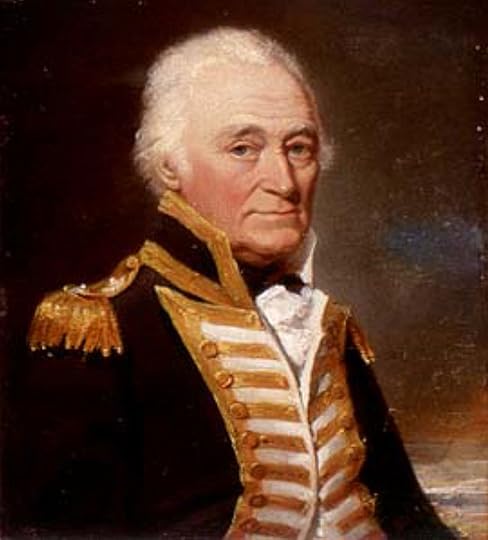 On 24th of November, 1804, Cornwallis’s fleet, including HMS Venerable, lay in the large anchorage at Torbay, in Devon. Deteriorating weather conditions, and an onshore gale, caused orders to be given to put to sea. HMS Venerable was under the command of Captain John Hunter (1737 –1821), whose portrait is shown on the left. Hunter had not only had an active naval career but had also served from 1795 to 1800 as the second governor of New South Wales, Australia. There he encouraged exploration and his name is commemorated in the Hunter Valley, north of Sydney. As governor, Hunter combatted serious abuses of power by the military authorities. In this period a contemporary described Hunter as “devoid of stiff pride, most accomplished in his profession, and, to sum up all, a worthy man.” He is also notable for having sent back to Britain the first known sketch and pelt of a platypus (of which Dr. Stephen Maturin would certainly have approved).
On 24th of November, 1804, Cornwallis’s fleet, including HMS Venerable, lay in the large anchorage at Torbay, in Devon. Deteriorating weather conditions, and an onshore gale, caused orders to be given to put to sea. HMS Venerable was under the command of Captain John Hunter (1737 –1821), whose portrait is shown on the left. Hunter had not only had an active naval career but had also served from 1795 to 1800 as the second governor of New South Wales, Australia. There he encouraged exploration and his name is commemorated in the Hunter Valley, north of Sydney. As governor, Hunter combatted serious abuses of power by the military authorities. In this period a contemporary described Hunter as “devoid of stiff pride, most accomplished in his profession, and, to sum up all, a worthy man.” He is also notable for having sent back to Britain the first known sketch and pelt of a platypus (of which Dr. Stephen Maturin would certainly have approved).
Darkness was falling as HMS Venerable began raising anchor. The operation went awry however and one seaman was thrown into the sea. The alarm was given and orders were given to drop a cutter to rescue him. In the process, one of the falls suddenly let go and the cutter plunged down into the water and filled. A midshipman and two seamen were drowned but a second cutter managed to rescue others in the water, including the man who had originally fallen overboard.
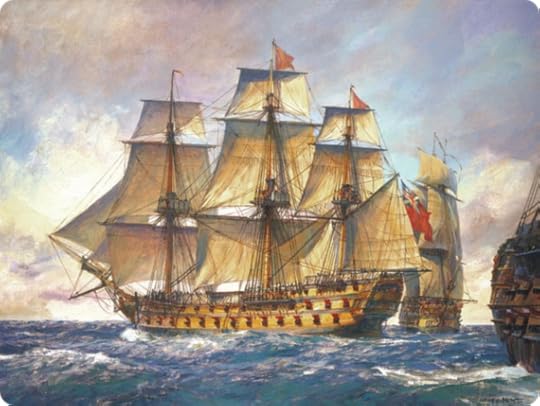
HMS Mars, a classic “74”. HMS Venerable was generally similar
While this drama was taking place, HMS Venerable was falling away before the gale and found it impossible to exit the bay. She was driven onshore at Paignton, practically at the mid-point of the bay’s semi-circular arc. She was clearly stuck immovably and it could only be a matter of time before she broke up. Orders were given to cut away the masts, in the hopes of their falling between the ship and the shore and so providing an escape route. This proved impossible however as, in grounding, the hull had been canted over away from the land. Captain Hunter remained in full control however – “with undaunted fortitude he continued to animate the crew with hope, and encouraged them to acts of further perseverance, with the same calmness and self-possession as if he were simply conducting the ordinary duties of his ship. From the moment the ship struck, not the least alteration took place in his looks, words, or manner; and everything that the most able and experienced seaman could suggest was done, but in vain.”
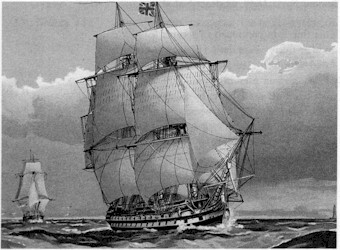
HMS Thunderer – another “74” of the era
HMS Venerable’s plight had not gone unnoticed. Two other 74s, HMS Goliath and HMS Impetueux, approached as closely as they dared in the circumstances and a cutter, HMS Frisk, stood in nearer still. Frisk was requested to anchor as close to HMS Venerable as she could so as to receive survivors, carried to her by pulling boats from Goliath and Impetueux.
Discipline prevailed as HMS Venerable’s crew were transferred to the boats and Captain Hunter and his officers declared that they would not leave the ship until the last seaman had been taken off. (It should be noted that at this time Hunter was sixty-seven years old, but this did nothing to decrease his resolution). The sea conditions were now so bad that the rescue boats could only come in under HMS Venerable’s stern, from which men were lowered by ropes. These efforts continued through darkness, raging seas and driving sleet. HMS Venerable was now practically on her beam ends, such that Hunter and his officers were now directing operations while standing – or rather holding on – on the outer side of the hull. All this time, HMS Venerable was pounding on the shore and likely to break up at any moment. It was close enough to the land – some twenty yards – to shout to helpers on shore and a line was eventually secured between them and the ship. Several men attempt to haul themselves to land along it but were plucked away to their deaths by the surf.
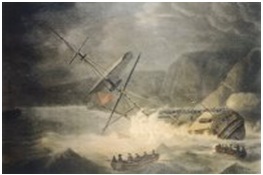
HMS Venerable grounded – note hull canted out seawards and conditions in which the rescue boats are operating.
Painting by Robert Dodd (1748 – 1816)
By five o’clock on the morning of the 25th – still dark and with the weather deteriorating yet further – only seventeen seamen remained on the ship with the officers. The sea was breaking over them and the fore part of the ship was wholly submerged. Only then did Captain Hunter order the final evacuation, his officers and himself to follow the men. One by one they dropped into the waiting boats – whose crews had by now been in action in the most dangerous conditions imaginable for more than six hours. Ultimately all, including Hunter himself, were brought across to HMS Impetueux. This was none too soon – shortly afterwards, HMS Venerable broke amidships and the part they had been huddled on capsized. Within sixteen hours of first striking, little remained of the ship but driftwood.
Only a handful of HMS Venerable’s crew were lost. Everybody involved on the Navy side came well out of this disaster – Hunter and his officers, his crew and the men who manned the Frisk and the boats of Goliath and Impetueux. Discipline and training had proved the keys to survival in the most desperate conditions, and the rescue – and the steadiness of officers and seamen alike – speak volumes about morale. Hunter himself was known as a humane and efficient commander and it is likely that this played no small part in his crew’s behaviour in extremis. Less impressive as the role played, or not played, by local people on shore. Not a single civilian boat put out from the fishing communities nearby and, according to a 19th Century commentator, “to add to this disgraceful conduct, the cowardly wretches were observed, when daylight broke, plundering everything of value as it floated ashore.”
It is pleasing to note that Hunter, when court-martialled for the loss of his ship, as he had to be, was fully acquitted. He promoted to rear-admiral two years later and to Vice Admiral in 1810, though he never hoisted his flag at sea. He died in 1821.
Naval Fiction in the Age of Fighting SteamBritannia’s Reach 1881: On a broad river deep in the heart of South America, a flotilla of paddle steamers thrashes slowly upstream. Laden with troops, horses and artillery, intent on conquest and revenge.
1881: On a broad river deep in the heart of South America, a flotilla of paddle steamers thrashes slowly upstream. Laden with troops, horses and artillery, intent on conquest and revenge.
Ahead lies a commercial empire that was wrested from a British consortium in a bloody revolution. Now the investors are determined to recoup their losses and are funding a vicious war to do so.
Nicholas Dawlish, an ambitious British naval officer, is playing a leading role in the expedition. But as brutal land and river battles mark its progress upriver, and as both sides inflict and endure ever greater suffering, stalemate threatens.
And Dawlish finds himself forced to make a terrible ethical choice if he is to return to Britain with some shreds of integrity remaining . . .
For US – click hereFor UK – click hereFor Australia and New Zealand – click hereAnd, as always, Kindle Unlimited subscribers can read it at no extra cost. The Dawlish Chronicles – now up to ten volumes, and counting. Click on the banner above for more details
The Dawlish Chronicles – now up to ten volumes, and counting. Click on the banner above for more detailsSix free short-stories are available for download to your Kindle. Access them by registering for the Dawlish Chronicles ma iling list – just click on the banner below. You’ll be kept updated on new books and will receive other free stories at intervals.
.fusion-body .fusion-builder-column-0{width:100% !important;margin-top : 0px;margin-bottom : 0px;}.fusion-builder-column-0 > .fusion-column-wrapper {padding-top : 0px !important;padding-right : 0px !important;margin-right : 1.92%;padding-bottom : 0px !important;padding-left : 0px !important;margin-left : 1.92%;}@media only screen and (max-width:1024px) {.fusion-body .fusion-builder-column-0{width:100% !important;}.fusion-builder-column-0 > .fusion-column-wrapper {margin-right : 1.92%;margin-left : 1.92%;}}@media only screen and (max-width:640px) {.fusion-body .fusion-builder-column-0{width:100% !important;}.fusion-builder-column-0 > .fusion-column-wrapper {margin-right : 1.92%;margin-left : 1.92%;}}.fusion-body .fusion-flex-container.fusion-builder-row-1{ padding-top : 0px;margin-top : 0px;padding-right : 20px;padding-bottom : 0px;margin-bottom : 0px;padding-left : 20px;}The post HMS Venerable, 1804 appeared first on dawlish chronicles.
June 24, 2022
French oared-galleys in British Waters – 1707
 Royal Navy frigate vs. French oared galleys – 1707
Royal Navy frigate vs. French oared galleys – 1707When one thinks of battles involving oared galleys one thinks automatically of actions in the Mediterranean. The lot of a galley slave chained to an oar must have been dreadful enough in the warm and usually calm waters of that sea, but it must have been infinitely worse in the cold, rough waters off the French Atlantic coast and in the North Sea. The galley’s day as a fighting vessel – a long one, stretching back two thousand years – ended in the early eighteenth century and as such they do not figure in most accounts of sea warfare of that era, as “Fighting Sail” reached its apogee of efficiency. I was therefore all the more surprised to come on an account in a Victorian publication of a battle with galleys in the Thames estuary in 1707. This was during the War of Spanish Succession, the last of Louis XIV’s wars, that which began the long decline of French power through much of the remaining century.
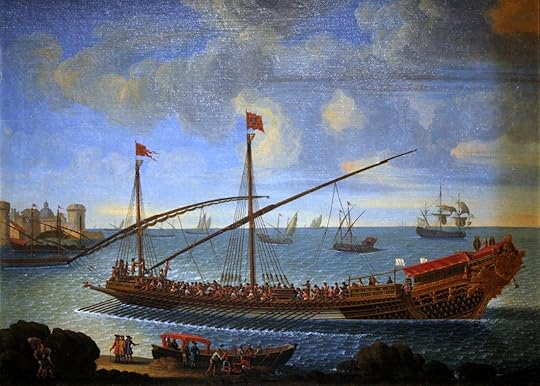 A réale galley of Louis XIV’s Mediterranean fleet.
Licensed under the Creative Commons Attribution-Share Alike 3.0 Unported license
A réale galley of Louis XIV’s Mediterranean fleet.
Licensed under the Creative Commons Attribution-Share Alike 3.0 Unported license
Louis XIV (a man much given to his own comfort and luxury, as his creation of the palace at Versailles testifies) appears to have been favourable to use of galleys and ordered that courts should sentence convicted criminals to serve as oarsmen in them as far as possible, even in peacetime. Though the idea was never implemented, he appears to have considered substitution of galley service for the death penalty. Considering that execution in France in this period was by the barbaric method of breaking on the wheel, being chained to an oar would probably have represented a marginally preferable fate.
In August 1707 a French force of six galleys, commanded by a Commodore Langeron, was off the Thames estuary, en route for an attack on the British port of Harwich. It was being guided by a Captain Thomas Smith, an English Jacobite who had taken service in the French navy after fleeing to France following the deposition of King James II from the British throne. Like many supporters of the exiled king, Smith had a bitter score to settle. The galleys appear to have been some 150-feet long and 22-feet in the beam, carrying sail on three masts and also propelled by oars pulled by some 200 chained slaves, most likely convicts. They carried around 12 guns. Though such vessels were obviously very manoeuvrable in Mediterranean conditions, one wonders just how well their high length to beam ratio would have made them workable in rougher Northern seas.
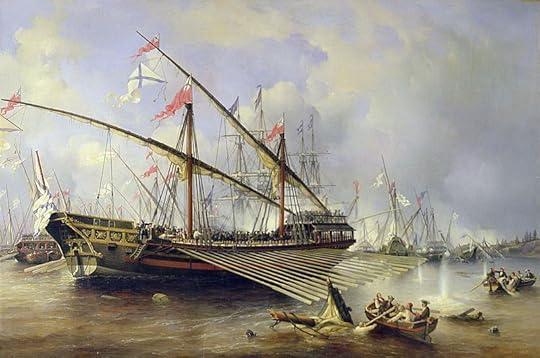 Battle of Grengam (a.k.a Ledsund) in 1720 by Ferdinand Perrot (1808–41).
Russian galley engaging Swedish frigates at close range
Battle of Grengam (a.k.a Ledsund) in 1720 by Ferdinand Perrot (1808–41).
Russian galley engaging Swedish frigates at close range

Captain Seth Jermy
This French squadron ran into a British convoy of thirty-six merchantmen coming from the Netherlands under the escort of a single frigate, the 20-gun HMS Nightingale, commanded by Captain Seth Jermy (1653–1724). On sighting the French Jermy ordered the convoy to crowd on sail and head up the Thames while he turned with his own single ship to meet the oncoming six vessels He must have known the odds to be hopeless – one is reminded of the epic last stands of the Rawalpindi and the Jervis Bay in WW2 – but his intention was to impose a sufficient delay to allow his charges to escape. Commodore Langeron, on the French side, decided to take on HMS Nightingale with his own galley, La Palme, and pressed on so fast that he left his next ship so far astern as to make it impossible to render direct assistance. As she closed with HMS Nightingale the French galley opened fire but the British frigate withheld hers and made no attempt to escape. Anticipating little resistance, and encountering only irregular fire from the frigate when the range had decreased to pistol-shot, Commodore Langeron decided on carrying her by boarding.
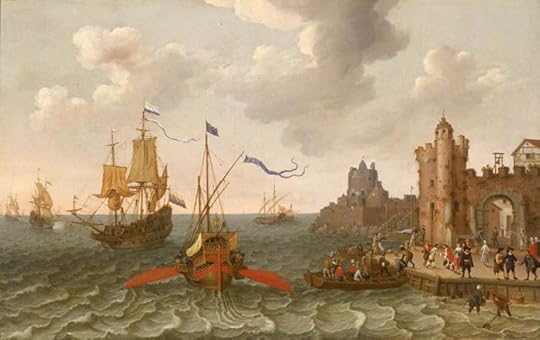 Abraham Willaerts (1603-1669): “A French Galley and a Dutch men-of-war off a Port” – painting shows just how vulnerable narrow-beamed galleys were in rough seas
Abraham Willaerts (1603-1669): “A French Galley and a Dutch men-of-war off a Port” – painting shows just how vulnerable narrow-beamed galleys were in rough seas
The preferred method of attack by galley appears to have been to use her superior manoeuvrability under oars to come bows-on to the enemy’s stern, rake her with cannon fire, then ram, locking both vessels together and pouring boarders across from elevated platforms on the foreship. As La Palme drove on Captain Jermy handled HMS Nightingale so skilfully that at the last moment she avoided her attacker’s viciously-pointed ram and he laid his own vessel alongside her. In the process HMS Nightingale smashed into the galley’s oars – the effect on the wretches chained to them must have been horrific. Only now did Jermy open with a full broadside, sweeping the enemy’s deck, the effect magnified by seamen in the fighting tops dropping grenades. Jermy then launched his own boarding party and a murderous hand-to-hand conflict began on La Palme’s deck. Commodore Langeron’s next galley in line finally arrived to join the fray and HMS Nightingale’s boarders, outnumbered, were forced back to their own ship, where most were subdued or killed.
 “English warships heeling in the breeze onshore” by Willem v/d Velde the Younger (1633-1707). Judging from their size, HMS Nightinale would have looked very similar
“English warships heeling in the breeze onshore” by Willem v/d Velde the Younger (1633-1707). Judging from their size, HMS Nightinale would have looked very similar
Captain Seth Jermy had retreated to his own cabin, which gave access to the gunpowder store. He repulsed French attempts to enter – shooting dead a sergeant of marines – and was contemplating blowing up the ship rather than surrender. Only when he saw that his merchant charges had gained safety was he prepared to listen to terms of surrender and to accept them. A French account recorded that when Jermy was brought before the French commander his appearance was unprepossessing – Commodore Langeron “could not help testifying his surprise at the inconsiderable figure which had made such a mighty uproar – he was humpbacked, pale-faced, and as much deformed in person as beautiful in mind.” Langeron’s reaction could not have been more gracious. He returned Jermy’s sword to him with the words: ”Take, sir, a weapon no man better deserves to wear; forget you are my prisoner, but remember I respect you for a friend.”
Captain Thomas Smith, the Jacobite in French service, seems to have borne himself well in the action and was rewarded with command of the captured Nightingale. He was to enjoy it only for a year, as he was captured by the British and executed as a traiter for his part in the attempt on Harwich. Jermy was exchanged with a French prisoner fourteen months after the battle and was immediately – and deservedly – appointed to another command. He retired from the navy in 1712.
And what of the men chained to the French oars? The record seems to say nothing of them. The mind recoils from considering their ultimate fates.
Britannia’s Innocent: The first chronologically of the Dawlish Chronicles Series:Typical 5-star review on Amazon, named “The most thoughtful Naval adventure series, ever.““Each of the Dawlish Chronicles is better than the last. Combines the action and adventure of Tom Clancy or Bernard Cornwell, with the sensibility of Henry James or Jack London. The hero perseveres in the face of adversity and remains true to his principles and evolving moral sensibilities: becoming more complete with each challenge. Not jingoistic, but a determined ethical man, who will fulfil his duty to the ends of the earth. I can’t wait for the next novel in this series! Thank you Mr Vanner for this fabulous hero placed so aptly into a backdrop of eminent Victorians.”
For more details, click below:For amazon.com For amazon.co.uk For amazon.com.auAs with all Dawlish Chronicles novels, Kindle Unlimited subscribers can read it at no extra cost.
 The Dawlish Chronicles – now up to ten volumes, and counting. Click on the banner above for more details
The Dawlish Chronicles – now up to ten volumes, and counting. Click on the banner above for more detailsSix free short stories are available for download to your Kindle. Access them by registering for the Dawlish Chronicles ma iling list – just click on the banner below. You’ll be kept updated on new books and will receive other free stories at intervals.
.fusion-body .fusion-builder-column-0{width:100% !important;margin-top : 0px;margin-bottom : 0px;}.fusion-builder-column-0 > .fusion-column-wrapper {padding-top : 0px !important;padding-right : 0px !important;margin-right : 1.92%;padding-bottom : 0px !important;padding-left : 0px !important;margin-left : 1.92%;}@media only screen and (max-width:1024px) {.fusion-body .fusion-builder-column-0{width:100% !important;}.fusion-builder-column-0 > .fusion-column-wrapper {margin-right : 1.92%;margin-left : 1.92%;}}@media only screen and (max-width:640px) {.fusion-body .fusion-builder-column-0{width:100% !important;}.fusion-builder-column-0 > .fusion-column-wrapper {margin-right : 1.92%;margin-left : 1.92%;}}.fusion-body .fusion-flex-container.fusion-builder-row-1{ padding-top : 0px;margin-top : 0px;padding-right : 20px;padding-bottom : 0px;margin-bottom : 0px;padding-left : 20px;}The post French oared-galleys in British Waters – 1707 appeared first on dawlish chronicles.
June 16, 2022
Fate of Zeppelin L-19, 1916
 The Fate of Zeppelin L-19, February 1916
The Fate of Zeppelin L-19, February 1916It is now over a century since bombing from the air became an integral feature of warfare, with civilian populations being at the mercy, at best, of collateral damage and, at worst, of deliberate targeting. It is therefore all the more difficult to comprehend the indignation and loathing aroused by the first deliberate bombing of civilian targets early in World War I. The large Zeppelin forces fielded by Imperial Germany’s separate Army and Navy organisations began the practice. They were used to strike British towns and cities, apparently in the hope of arousing widespread panic among the civilian population and thereby cutting into industrial production. The physical results were wholly disproportionate to the demands made on strategic resources (notably aluminium) and the most concrete single result was to give a gift to Allied propagandists who could label the Germans “baby killers” since children were inevitably among the victims. Imposing and ominous sights these airships might have been, but their load-carrying ability was limited and they were underpowered in relation to the vast forces imposed on them by weather. If they could be detected by defending aircraft – and that was a major “if” at night, and even in daytime, in those pre-radar days – these hydrogen- laden airships were spectacularly vulnerable to fixed-wing aircraft firing incendiary bullets. Adding to these drawbacks was the difficulty of navigation and inability to locate even city-sized targets with any hope of success – the necessary technology did not emerge until the early years of World War II. The vulnerability and essential uselessness of these airships as an offensive weapon are epitomised by the fate of Zeppelin L-19 in February 1916, a case that also raised serious ethical issues.
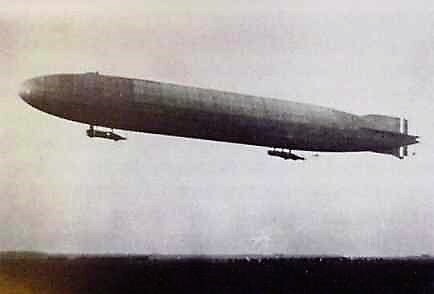
L-19 in flight
L-19 was a 536-feet long rigid airship powered by four 240-Hp Maybach petrol engines which gave it a maximum speed in still air of 60-mph. Any headwind would obviously cut into this speed and winds from the flank would cause drift off course. Her bomb capacity was significant for her day – rated at 3530-lbs (just over one and a half tons.) She entered service German Navy service in late November 1915 and in the next two months made reconnaissance flights over the North Sea. On 31st January 1916 she joined eight other airships the largest air-raid yet mounted on Britain. Leaving the base at Tondern in Schleswig at noon she headed westwards across the North Sea, the objective being “targets of opportunity” in England, including Liverpool, if it could be reached. Heavy rain and snow were encountered and the Zeppelins crossed the English coast individually some six to seven hours after departure, meaning that they were by then flying in darkness. The L-19 was the last of the force to arrive, passing over Norfolk and locating Burton-on-Trent some 140 miles further west in the English Midlands. Here she dropped part of her bombs before flying south-west towards Birmingham where the remainder were unloaded. It was possible that the commander did not know where he was – the crew of one of other Zeppelins that reached Burton believed that they had bombed Liverpool, in actuality far to the North West. The damage inflicted by the L-19 was minimal – a public house destroyed, some farm animals killed, but no people injured. The raid as a whole killed 61 people on the ground and injured 101. The effect on Britani’s ability to wage war was undiminished but anti-German feeling would be raised to a new pitch.
[image error]
Inside a Zeppelin gondola – illustration from 1917
The L-19’s tragedy was now just beginning however. She had problems with her engines – a new design that was showing signs of unreliability in service – and indeed more than half of the other airships involved in the raid had such troubles also. As she headed back eastwards over England and out into the Southern North Sea, the L-19 signalled by radio the results of her bombing and requested a position-fix by radio-triangulation. By the time of her final signal, at 0400 hours on 1st February, she reported problems with her radio and that three of her four engines were out of action, leaving her wholly at the mercy of the weather. She was then some 20 miles north of the Friesan Island of Ameland, off the northern Dutch coast. Some while later she drifted across Ameland itself and Dutch forces there, though neutral, fired on her – ineffectively – with rifles. The L-19 seems to have remained powerless through the day that followed and a southerly wind carried her northwards. Sometime during the nights of 1st – 2nd February the L-19 came down in the sea. The captain dropped a bottle – it contained a report of the airship’s predicament and letters to his family. It was only picked up long afterwards. Without information on L-19’s position, it is not surprising that German efforts to locate her proved futile.
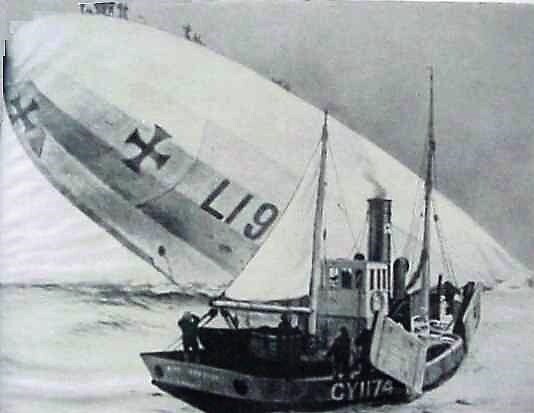
Morning 2nd February, rescue apparently at hand – contemporary illustration
The airship was still afloat, with her sixteen-man crew clustered on top. They had fired flares during the night and these drew the attention of a British fishing vessel, the civilian King Stephen steam-trawler, commanded by a Skipper William Martin (1869–1917). Hope of rescue rose as the English-speaking German airship captain hailed the King Stephen and asked for his crew to be taken aboard. Skipper Martin of the King William refused, on the grounds that his own unarmed nine-man crew could be overpowered and his vessel taken to a German port. Pledges by the German captain of honourable behaviour and offers of financial reward did not shake Martin’s resolve. He did however undertake to report the airship’s location to any British warships he would encounter. He was to meet none and the incident was not reported until the King Stephen docked at the fishing port of Grimsby on the British East coast. The weather had been worsening as she left the L-19. No trace of the airship was found thereafter by searching British warships though several more messages in bottles and the body of a single crew member were later washed up.
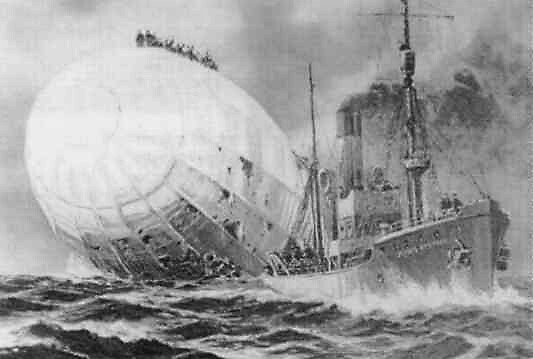
The King Stephen sails away – note crew on top of L-19 – by German artist Adolf Bock
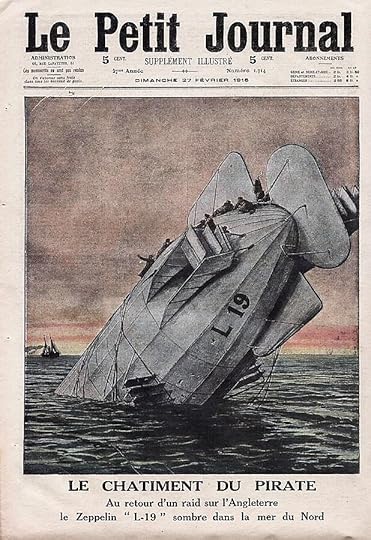
L-19 as imagined by a French magazine
Skipper William Martin’s dilemma was a terrible one, and, on balance, it is hard to condemn his decision to leave sixteen men to their fate provided he reported their location. Even allowing for anti-German “baby killer” propaganda, concern for his crew offered an arguable justification. Pro and contra views were taken in Britain and Martin received mail both praising and excoriating him. The Anglican bishop of London was a stalwart supporter of his action. Martin died of a heart attack the following year, brought on perhaps by the controversy. The incident proved counterproductive in propaganda terms, allowing Germany to counter “baby killer” accusations by referencing the L-19’s men being left to their death when deliverance was at hand.
The King Stephen / L-19 incident may not however have been as straightforward as portrayed at the time. Investigation of Admiralty archives in the early 1960s, and interviews with the trawler’s two surviving crew members, indicated that the position reported by Skipper Martin may have been deliberately incorrect, resulting in the Royal Navy’s futile search efforts being concentrated in a wrong area. The reason appeared to be that he had been fishing in a forbidden zone and that he did not want to reveal the fact. The King Stephen’s own remaining life was to be short one – taken into Royal Navy service she was sunk twelve weeks after L-19 had gone to the bottom.
Over a century later it is difficult to judge or to condemn any of the parties involved – unless Skipper Martin was in fact lying. Total war, with all its horrors, was a new reality and hard decisions would lie ahead in land, sea and air combat. The ultimate responsibility for the fate of the L-19’s crew – dedicated professionals doing a difficult job – lies far from them and rests forever on other shoulders.
Start the 10-volume Dawlish Chronicles series of novels with the chronologically earliest:Britannia’s InnocentTypical Review on Amazon from an American reader, who heads it:“Once again, maybe Vanner’s best! Just a really good book!”“I have to say, I love this series. I wait for each new book and I read it as soon as it comes out, and it never disappoints. This is such a rich area of naval history that has rarely been visited, and Vanner is an extremely capable writer. I love the way he weaves his story around actual events, and I also love the way he acknowledges and embraces the impacts of technology on recent history, especially naval history. Finally, I just have to say that Vanner, as a writer, just keeps getting better. He was good at the start, but now his prose is lucid, succinct, and crisp, muscular where needed, delicate when that’s required, and all in all extremely readable and enjoyable. If you haven’t read any other books in the series, don’t worry. Like other really good writers of serial fiction, Vanner makes each book stand easily on its own. So don’t hesitate, dive on in. You’ll enjoy the read!”
For more details, click below:For amazon.com For amazon.co.uk For amazon.com.auAnd, as always, Kindle Unlimited subscribers can read it at no extra cost.The Dawlish Chronicles – now up to ten volumes, and counting … The Dawlish Chronicles – now up to ten volumes, and counting. Click on the banner above for more details
The Dawlish Chronicles – now up to ten volumes, and counting. Click on the banner above for more detailsSix free short-stories are available for download to your Kindle. Access them by registering for the Dawlish Chronicles ma iling list – just click on the banner below. You’ll be kept updated on new books and will receive other free stories at intervals.
.fusion-body .fusion-builder-column-0{width:100% !important;margin-top : 0px;margin-bottom : 0px;}.fusion-builder-column-0 > .fusion-column-wrapper {padding-top : 0px !important;padding-right : 0px !important;margin-right : 1.92%;padding-bottom : 0px !important;padding-left : 0px !important;margin-left : 1.92%;}@media only screen and (max-width:1024px) {.fusion-body .fusion-builder-column-0{width:100% !important;}.fusion-builder-column-0 > .fusion-column-wrapper {margin-right : 1.92%;margin-left : 1.92%;}}@media only screen and (max-width:640px) {.fusion-body .fusion-builder-column-0{width:100% !important;}.fusion-builder-column-0 > .fusion-column-wrapper {margin-right : 1.92%;margin-left : 1.92%;}}.fusion-body .fusion-flex-container.fusion-builder-row-1{ padding-top : 0px;margin-top : 0px;padding-right : 20px;padding-bottom : 0px;margin-bottom : 0px;padding-left : 20px;}The post Fate of Zeppelin L-19, 1916 appeared first on dawlish chronicles.
June 9, 2022
French Submarine Curie 1914
 One Submarine, Two Flags and Two Heroes: WW1
One Submarine, Two Flags and Two Heroes: WW1Two spectacular cases of submarines penetrating enemy anchorages are well known to naval-history enthusiasts. The first was when the Royal Navy’s E14, commanded by Lieutenant Commander Edward Boyle, surfaced in the Golden Horn, in the heart of Istanbul, in May 1915. This followed penetration of the heavily-mined Dardanelles and was part of a successful campaign against Turkish shipping. The second instance was when Germany’s U-47, commanded by Kapitänleutnant Gunter Prien, found her way through the defences of the Royal Navy’s protected anchorage at Scapa Flow in 1939 and sank the battleship Royal Oak at anchor there.
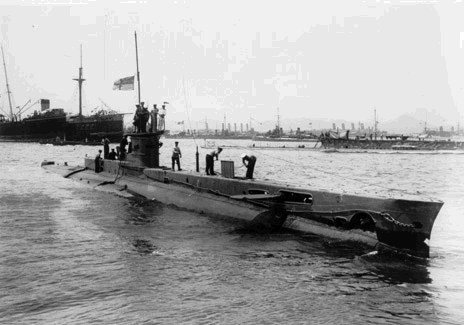
Boyle’s E14
A third equally daring action is this type deserves to be better known and, though it ended in tragedy, it involved courage and skill of a very high order. It was also to be the prelude to an amazing – and unlikely – second career for the submarine involved. The story also links two decent and heroic men who, in other circumstances, might well have valued each other as friends.
The submarine was a combat-unproven weapon at the outbreak of war in 1914. Several major navies, including that of France as well of those of Britain, Germany and the United States, had however invested heavily in such vessels in the previous decade. Extensive testing and evaluation of operational procedures had been undertaken and a number of second-rank navies were rapidly following suit. Alternative design approaches were still being investigated and French development followed a somewhat different track than that of other navies. This was epitomised by the large number – 34 in total – of generally similar Brumaire-class and Pluviôse-class boats designed by Maxime Laubeuf. Though all had electrical underwater-propulsion, several of the earlier-constructed units were powered on the surface by steam – which slowed diving and proved impractical operationally. (The French experience was not taken to heart by the Royal Navy, which later committed heavily to its own disastrous K-class). Later Brumaire/ Pluviôse boats had diesel power for surface running.

The steam-driven Vendemiaire of the Pluivose class
These craft were 167 to 171 feet long and had a surface displacement of 398 tons. In their time they were innovative as being of double hull construction. This involved a generally cylindrical inner hull, strong enough to resist external pressure, but with an outer, boat-shaped hull to improve surface seakeeping. Novel when new, these features became standard thereafter in most other navies. To modern eyes however the Brumaire and Pluviôse classes had a strange appearance, unlike those of other navies of the time, whose vessels looked generally similar to those we see today. The Laubeuf boats had no coning tower (or in modern parlance “sail”) as such, only a small, low open bridge for steering on the surface. Extending fore and aft of this platform was a walkway supported on stanchions. In the open space below this were four “Drzewiecki” drop-collars which each carried an 18-inch torpedo at the start of a cruise, with two reloads carried in cradles beneath the walkway. These six torpedoes were therefore carried externally and these, plus the walkway, can only have added significantly to parasitic drag. There was in addition a single 18” torpedo tube in the bow, into which a reload could be inserted from within without the need to surface – as was impossible with the drop-collars. Carrying eight torpedoes, these boats had a very powerful offensive capability.
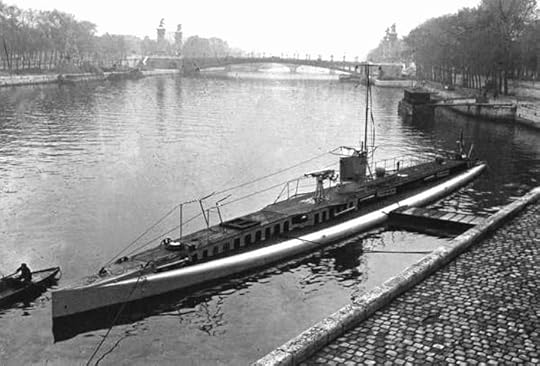
Montgolfier, Brumaire-Class submarine, sister of Curie, seen on the Seine in Paris (!!!)
The Curie, launched in 1912, belonged to the Brumaire-class, with diesel power for surface running. In August 1914, when France and Britain went to war with the Central Powers – Germany and Austro-Hungary – Curie was assigned to supporting the French Navy’s attempt to close off the Otranto Straits between Southern Italy and Greece. By so doing they would bottle-up the efficient and locally powerful Austro-Hungarian navy within the Adriatic. Blockade was however a slow process and more daring spirits considered the possibility of infiltrating a submarine into the main Austro-Hungarian naval base at Pola, close to the head of the Adriatic, so as to sink major units moored there.
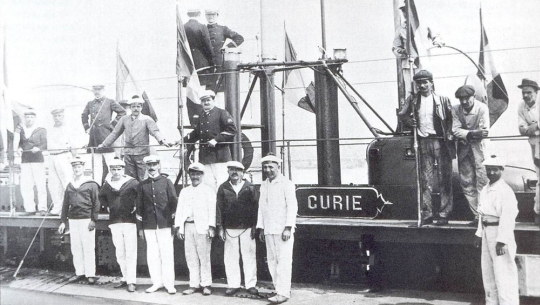
Some of Curie’s crew – note the tiny steering platform
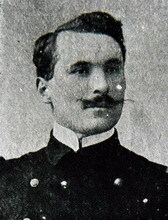
Gabriel O’Byrne
Curie was chosen for the mission, probably not least because of the competence and obvious flair of her commander, who had apparently conceived the idea of such an attack. Born in 1882, Lieutenant 1stClass Gabriel O’Byrne was, despite his name, French, a descendent of one of the Irish “Wild Geese” who entered French service during the 18th Century when Penal Laws in Ireland barred Catholics from any significant British Civil or Military service. Entering the Navy in 1896, O’Byrne was to see service in China during the Boxer Rising in 1900 and was later to specialise in submarines, taking command of the Curie shortly after her commissioning.
On December 17th 1914 the Curie was towed halfway up the Adriatic by the armoured cruiser Jules-Michelet. It should be noted that at this time Italy was still neutral and operation from an Italian base nearer to Pola was not an option. The Curie, with a complement of 29 and her mascot dog (called, most appropriately, “Radium”), was cast off 150 miles from Pola. She spent the following day approaching the Austro-Hungarian base, making most of the passage on the surface. She submerged closer to shore, passing unwittingly but safely through a defensive minefield. December 19th was spent probing the harbour’s approaches and defences – which were complex, as can be seen from the contemporary illustration below. Still undetected, O’Byrne resolved to make his entrance, submerged, on December 20th.
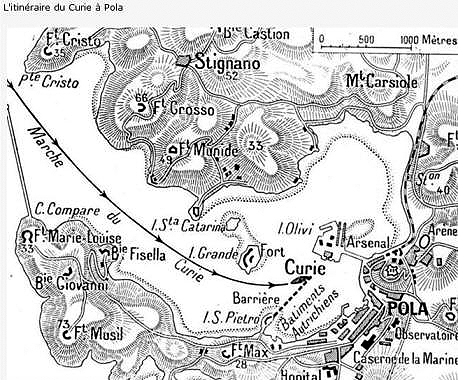
Maintaining a depth of some 60 feet, Curie reached the harbour’s outer boom around midday. Scraping of short duration was heard as she passed what appeared to be the mooring cables of the outer boom. O’Byrne now took her up to periscope depth and saw, too late, the buoys of a second boom directly ahead. The Curie was almost instantly caught in steel netting. Ballast tanks were vented in desperate attempts to sink free and the crew were set to race back and forth to alter trim while the motors raced to drag the craft clear. It was to no avail. The propellers themselves became entangled and soon the over-heated electric motors threatened to burn out. These efforts continued for four hours and the air became increasingly so foul that the dog died of asphyxiation and the crew were in little better shape. The last attempt to break free pitched the craft 30 degrees bow-down. This caused sea-water to reach the battery terminals, thereby releasing poisonous chlorine gas.
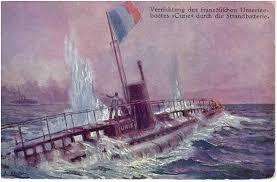
Curie under fire – French postcard. The flag is probably an artist’s invention!
The situation was now hopeless. O’Byrne destroyed his secret documents and ordered surfacing, knowing from the sounds of nearby propellers that there were enemy vessels almost directly overhead. As the Curie broke surface these vessels opened fire on her, as did a nearby shore battery. One shell penetrated the steering position, another the pressure hull. O’Byrne now ordered “Abandon ship!” and opened all vents to scuttle the craft. He himself was wounded – in the lungs – and his second-in-command, Lieutenant Pierre Chailley, had been killed outright. The coxswain had been wounded badly enough to die in hospital shortly after. O’Byrne had to be dissuaded from going down with his command. He found himself in the icy water with his men for the next hour until they were rescued by boats from one of the Curie’s intended targets, the dreadnought Viribus Unitis. All the prisoners were treated with dignity – indeed admiration – and in view of the gravity of his injuries, O’Byrne was sent to a hospital in Graz in Austria. Here, in June 1915, the Austro-Hungarian authorities allowed his wife to come from France to care for him. Here we’ll leave O’Byrne for now, but we’ll return to him later.

Under new management: Curie reborn as U-14. Note the heightened surface steering platform.

George von Trapp
Austro-Hungarian efforts to raise the Curie began immediately and she broke surface in early February 1915. It was ascertained that she could be made serviceable. She was given what amounted to a raised coning tower – essential for long-term surface seakeeping – as well as more powerful electric motors, a new battery and an 88mm gun for surface attacks. She was given extra fuel tanks, which increased her radius of operation on the surface significantly and in June 1915 she was commissioned as U-14 of the Austro-Hungarian Navy. She was to see no success under her first commander, who fell ill, but in October her new captain was to be Linienschiffsleutnant Georg Ritter von Trapp. This officer had already scored signal successes with his previous boat, U-5, and he was to prove himself the most successful Austro-Hungarian submarine ace of the war. His later career saw him as the patriarch of the von Trapp family singers – as per the musical “The Sound of Music” and he was to be played in the movie version by Christopher Plummer. By the end of the war von Trapp had completed nineteen war patrols, sinking over 45,000 tons of merchant shipping, plus the French armoured cruiser Leon Gambetta and the French submarine Nereide. Among his victims was the Italian bulk-carrier SS Milazzo of 11500 tons and at the time the largest merchant ship afloat. At the end of the war, the U-14 was recovered by France and served in the French Navy until scrapped in 1929.
And what of O’Byrne? Though well treated in Austria, his health did not improve and he was repatriated to France, via Switzerland and the Red Cross, in 1917, dying shortly afterwards. He left his wife and two children. Rightly recognised as a hero, he was decorated as a Chevalier of the Légion d’Honneur and received the Croix de Guerre. A recognition that he might have valued even more was that the lead-vessel of a three-boat class of submarine was to be named after him. Launched in 1919, the O’Byrne was to serve in the French Navy until 1935. A similar honour was deservedly accorded to the Curie’s second in command, Pierre Chailley, killed during the Pola attack, the second boat of the class being named after him and serving until 1936.
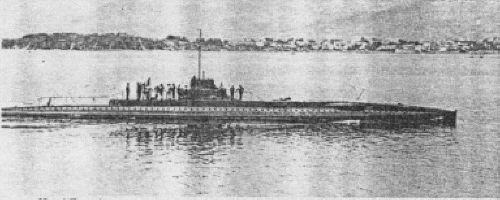
Henry Foournier, third boat of the O’Byrne class, 1921
Chivalrous by nature, and lacking employment when the breakup of the Empire cost both Austria and Hungary their coastlines, and with them their need for a navy, von Trapp fell on hard times in the aftermath of the Great War. His private life and a new career thereafter were to provide not-unwelcome surprises however. A decent man, and unwilling to compromise his principles, he was forced to flee his native country after the Nazi take-over and was to die in the United States in 1947.
As I pieced together this story I was struck by the pronounced similarity of both O’Byrne and von Trapp. Brave, resourceful and dedicated, and from very similar social and religious backgrounds, they both remained men of integrity. It’s easy to imagine them as friends in different circumstances. I found myself reminded of Thomas Hardy’s lines in his poem “The Man He Killed”:
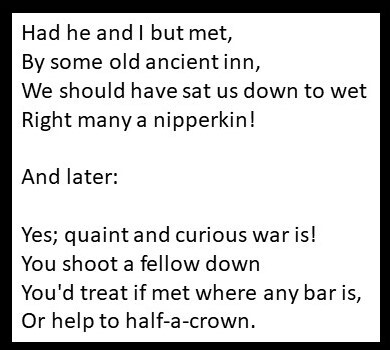
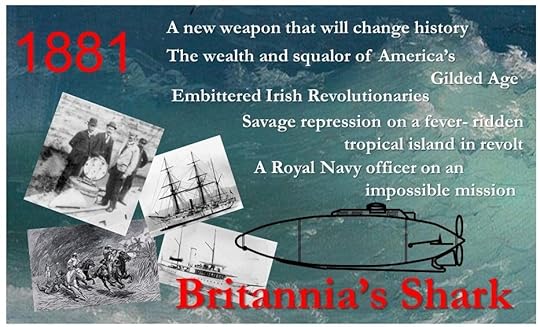 Readers of my novel Britannia’s Shark may remember Commander Nicholas Dawlish RN having a brief encounter with von Trapp’s father August, also a naval officer, in April 1881. “The tight-lipped Fregattenkapitän” had led an enquiry on behalf of the Austro-Hungarian Navy into an incident in which Dawlish took little pride. And this was to lead in turn to a nightmare experience with a prototype submarine developed by bitter Irish revolutionaries. Amid the wealth and squalor of America’s Gilded Age, and on a fever-ridden island ruled by savage tyranny, and manipulated ruthlessly from London by the shadowy Admiral Topcliffe, Nicholas Dawlish and his wife Florence must make some very strange alliances if they are to survive – and prevail.
Readers of my novel Britannia’s Shark may remember Commander Nicholas Dawlish RN having a brief encounter with von Trapp’s father August, also a naval officer, in April 1881. “The tight-lipped Fregattenkapitän” had led an enquiry on behalf of the Austro-Hungarian Navy into an incident in which Dawlish took little pride. And this was to lead in turn to a nightmare experience with a prototype submarine developed by bitter Irish revolutionaries. Amid the wealth and squalor of America’s Gilded Age, and on a fever-ridden island ruled by savage tyranny, and manipulated ruthlessly from London by the shadowy Admiral Topcliffe, Nicholas Dawlish and his wife Florence must make some very strange alliances if they are to survive – and prevail.
 The Dawlish Chronicles – now up to ten volumes, and counting. Click on the banner above for more details
The Dawlish Chronicles – now up to ten volumes, and counting. Click on the banner above for more detailsSix free short-stories are available for download to your Kindle. Access them by registering for the Dawlish Chronicles ma iling list – just click on the banner below. You’ll be kept updated on new books and will receive other free stories at intervals.
.fusion-body .fusion-builder-column-0{width:100% !important;margin-top : 0px;margin-bottom : 0px;}.fusion-builder-column-0 > .fusion-column-wrapper {padding-top : 0px !important;padding-right : 0px !important;margin-right : 1.92%;padding-bottom : 0px !important;padding-left : 0px !important;margin-left : 1.92%;}@media only screen and (max-width:1024px) {.fusion-body .fusion-builder-column-0{width:100% !important;}.fusion-builder-column-0 > .fusion-column-wrapper {margin-right : 1.92%;margin-left : 1.92%;}}@media only screen and (max-width:640px) {.fusion-body .fusion-builder-column-0{width:100% !important;}.fusion-builder-column-0 > .fusion-column-wrapper {margin-right : 1.92%;margin-left : 1.92%;}}.fusion-body .fusion-flex-container.fusion-builder-row-1{ padding-top : 0px;margin-top : 0px;padding-right : 20px;padding-bottom : 0px;margin-bottom : 0px;padding-left : 20px;}The post French Submarine Curie 1914 appeared first on dawlish chronicles.




